The Many Versions of Superman in the Comics & Other Media & Other Thoughts about the Depiction of the Man of Steel & His Supporting Cast
through the Years
 Original Golden Age Superman
Original Golden Age Superman
Superman of the Radio Serial
Superman of the Movie Serials
Adventures of Superman Television Series
Hollywoodland (2006 film account of George Reeves’ life)
Silver Age Superman
The New Adventures of Superman Animated TV Series
Bronze Age Superman
Check out Supes, Vartox, Kara, Lex, Lois, Brainiac, & Mxy on my
Favorite Characters from Pop Culture Page.
See where Supes,
Lex,
Brainiac,
Mxy,
Vartox,
Mongul,
Kara,
Darkseid,
Parasite,
Zod,
Metallo,
Bizarro,
Faora Hu-Ul,
Karb-Brak,
Lord Satanis, &
Atomic Skull
placed on my Top 50 Super-Heroes (& -Villains) Pages.
Original Golden Age Superman
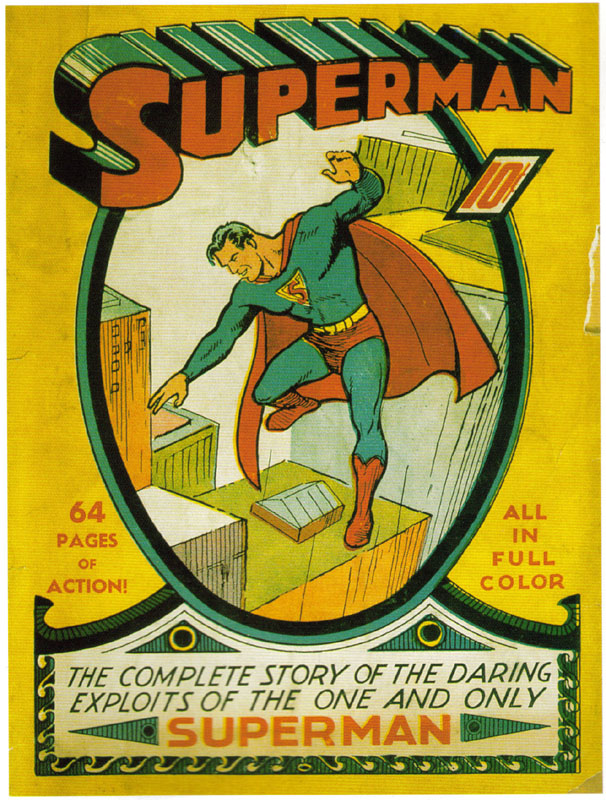

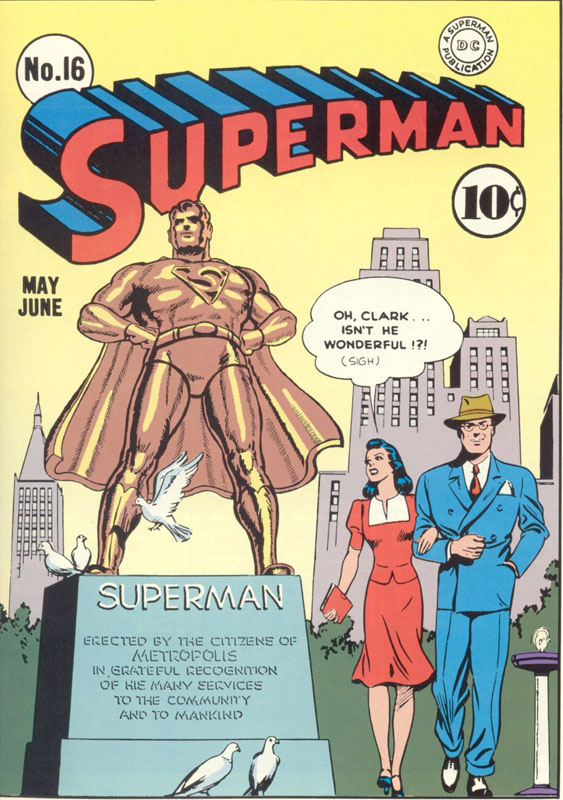
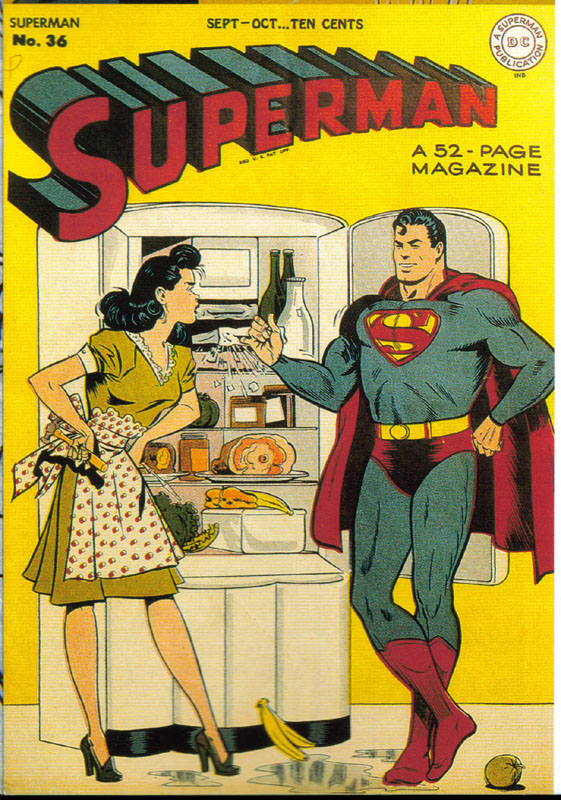
When Jerry Siegel (1914-1996) & Joe Shuster (1914-1992) published the first Superman tale, he was the only comic book super-hero on the scene. He had
superhuman strength and toughness and the ability to leap 1/8th of a mile. The Man of Tomorrow’s powers were his heritage as the member of an advanced,
alien race. As the ranks of comic book costumed crimefighters proliferated, Superman’s abilities escalated too. In fact, although the broadening of the
Action Ace’s abilities is often called a “gradual evolution,” the fact is that his powers expanded explosively in the first five years, undergoing rapid
refinement for the next three years and settling into a slower-paced development to near-omnipotence by the end of the 1950s.
Superman’s power of flight was actually one of the slowest to progress. From 1938 to 1941, the Man of Steel’s leaps became longer and longer with
increasingly elaborate trajectories until, in Superman #10 and #11 (May 1941), the Metropolis Marvel is pictured hovering, changing course in midair,
and executing complex aerial maneuvers. Evidently, these events were missed or contended by part of the creative team, as, over the next two years,
Superman is described as “springing,” “gliding,” and “sailing,” but not flying. However, by the time of Action Comics #65 (October 1943), to continue
classifying his “leaps” as anything but true, powered flight would have been dishonest. In August 1947 (Action Comics #111), although he had been
portrayed exceeding the speed of light years earlier, Superman first uses his speed to break the “time barrier” and physically displace himself into
the past.
Superman’s keen senses quickly transformed into superhuman abilities. By April 1939 (Action Comics #11), the Last Son of Krypton had x-ray vision.
By September 1939 (Superman #2), he had super-hearing. By January 1947 (World’s Finest #26), the Man of Tomorrow had acquired super-smell.
In July 1949 (Superman #59), the Action Ace began using his “x-ray vision” to melt and burn objects. This power did not receive its present
appellation “heat vision” until Action Comics #275 (April 1961).
Strangely, the inability of Superman’s x-ray vision to pierce the element lead is revealed in February 1944 (Action Comics #69) almost six years
prior to the first appearance of green kryptonite in Superman #61 (November 1949)—but not before kryptonite’s actual 1943 debut on
The Adventures of Superman radio serial.
In October 1946 (Action Comics #101), the Man of Steel’s invulnerability reaches its peak when Superman survives the simultaneous explosion of not
one, but two atomic bombs.

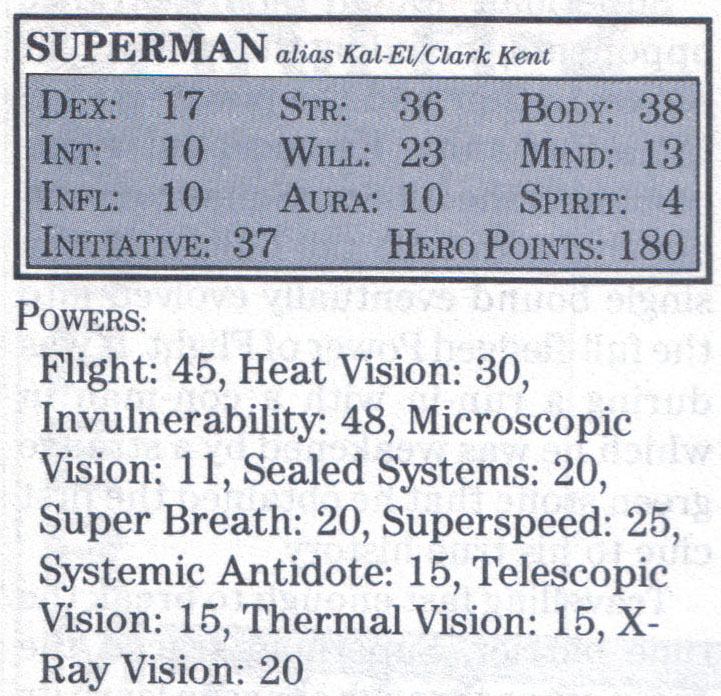
Therefore, all of Superman’s powers had reached critical thresholds or climaxes long before the supposed 1956 division of his career (and person!) into
Golden and Silver Age versions. Much is made of the differences between the Golden Age Superman and the Silver Age Superman, particularly the
flightlessness of the original Metropolis Marvel. Although the differences are great, the issue of flight is a trivial one as the comic book Caped
Kryptonian was without it (and just barely, at that) for only five years. Ironically, when DC published DC Heroes in 1985, the role-playing game based
on the DC Universe, the statistics accorded the Golden Age Superman (depicted above, right) indicated that he could fly just as fast as the Silver Age
Action Ace—several thousands of times the speed of light! In fact, this is one of the few points at which their powers are equal. The Golden Age
Superman was reported as weaker and less intelligent with slightly less potent sensory powers.
For the first seven years of his existence, stories maintained that the Golden Age Superman had arrived on Earth as an adult. Suddenly, in 1945,
readers learned that the Action Ace had arrived as a child and had a career as the Boy of Steel before growing into a man. A few cynical souls ascribe
the invention of Superboy to the popularity of young sidekicks, such as Robin, Bucky, & Captain Marvel, Jr.
The first newspaper for which Kent worked was called the Daily Star, and his editor there was George Taylor. Less than a year later, when DC began
publishing the newspaper daily strip starring the Man of Tomorrow, the name of the paper Kent worked for was changed from the Daily Star to the Daily
Planet. Both the comic and the radio serial, which debuted the following year, reflected this change.
For 12 years, Superman truly was the Last Son of Krypton; the first survivors of the doomed planet besides Kal-El (Mala, U-Ban, and Kizo) appeared in 1950.
Two villains of note appeared during the Golden Age—namely, Luthor (1940) and Mr Mxyztplk (1944). (Mxyztplk actually appeared in the newspaper
comic strip six months before his first comic book appearance in Superman #30.) In Luthor’s first three comic book appearances, he was slim and
had red hair. In his next appearance in the newspaper daily strip, however, Luthor was depicted as portly and bald. Some claim that the switch was a
simple mistake, while others say the change was due to the influence of Captain Marvel’s Dr Sivana. Whichever the case, from 1941 onward, Luthor was bald.
Superman of the Radio Serial & of the 17 short animated films produced by Fleischer Studios and Famous Studios
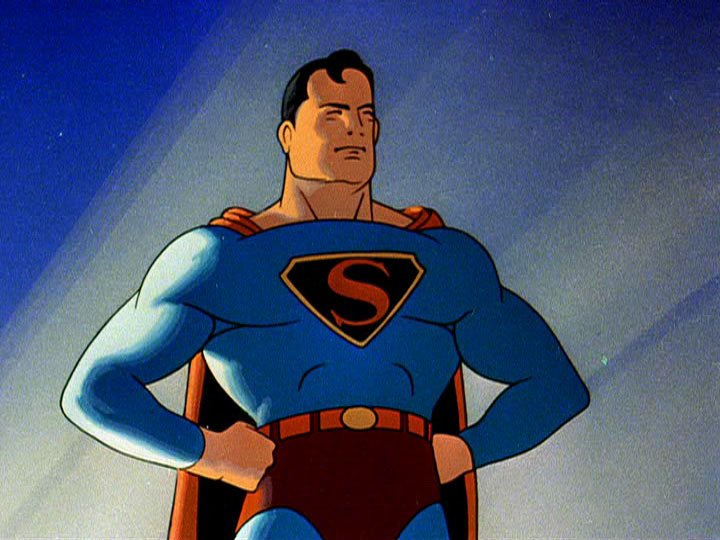
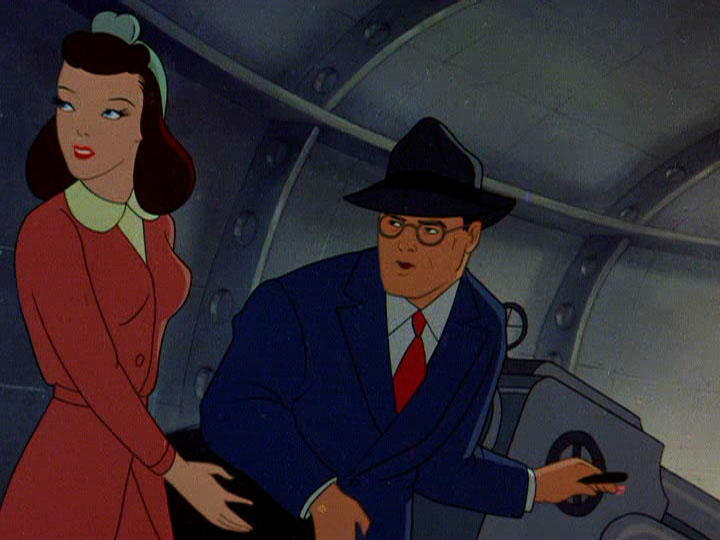
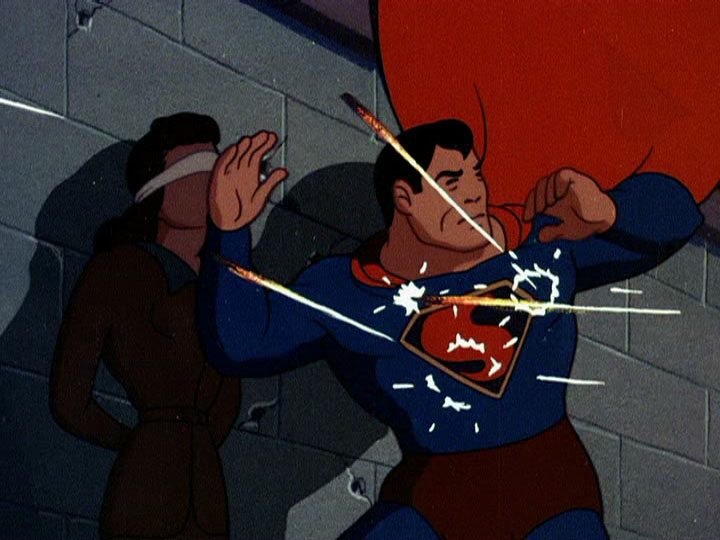
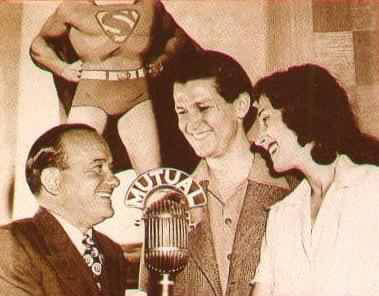
Bud Collyer (1908-1969) [pictured above, far right, center of photo] was the voice of Superman on the radio and in theatrical animated shorts from 1940 to 1951.
The Man of Steel as portrayed on the airwaves did not differ significantly from the comic book Golden Age Superman. In the very first episode, the
announcer declares in the preface that Superman can leap 1/8th of a mile and over a 20-story building and that he is “faster than an airplane.” The
names of his parents, Jor-El and Lara, along with his own Kryptonian name, Kal-El, are all mentioned. Also mentioned is the fact that Kryptonians, when
they take a step, can move practically any distance. In the second episode, although Kal-El departed Krypton as a child, he arrives on Earth as an adult.
The second episode begins with the famous words, phrased somewhat differently, “Up in the sky—look! It’s a bird, it’s a plane, it’s Superman!” In the
episode, Superman is described as “hovering” and “flying.”
The radio serial proved to be a source of creative change for the comic. Perry White, Jimmy Olsen, Kryptonite, and the Superman/
Batman (World’s Finest)
team all appeared on The Adventures of Superman before their integration into the comic books.
Bud Collyer also lent his voice to the Man of Steel for the first seven of the series of 17 short animated films produced by Fleischer Studios and Famous Studios
from 1941 to 1943. These cartoons owed the radio serial not only the voice-actors but the theme music as well. The shorts, quite unlike the radio program,
have very little dialogue, & plot tension never results from the threat of Superman’s secret identity being uncovered.
In the Filmation television cartoon series of the late 1960s, Collyer reprised his role as the voice of Clark Kent and the Caped Kryptonian.
Collyer, therefore, portrayed Superman over a longer period and for more absolute running time than any other actor—live or voice.
“Look! Up in the Sky!” “Never-ending battle for truth, justice, and the American way.” “Up, up, and away!” “This is a job for . . . Superman!” All of
these famous catchphrases associated with the Last Son of Krypton originated on The Adventures of Superman radio program.
“Faster than a speeding bullet! More powerful than a locomotive! Able to leap tall buildings in a single bound!” originated in the animated films of the
Fleischer Studios and continued on in the radio serial and later in the Adventures of Superman television series.
Toward the end of the radio serial’s run, Batman was featured practically in every other storyline.
In The Adventures of Superman, the Man of Tomorrow dealt mostly with crooks, thugs, Nazi spies, and corrupt political bosses. Collyer’s Superman
occasionally had adventures on the moon or other planets and dealt with extraterrestrial menaces there. From time to time, a crook employed a
technologically advanced weapon or device. None of the familiar super-villains from the comic made appearances. The radio show only introduced two
characters that could be considered super-villains—the kryptonite-powered Atom Man and Butcher Stark, a criminal whose voice was ultra-loud and could
incapacitate the Man of Steel. Four other recurring criminals almost fit the bill as super-villains: the Laugher, the Leopard Woman, the Scarlet Widow,
and Der Teufel (the Devil). These villains all had a motif or gimmick and were known only by their “villain name.” However, as these foes lacked
distinctive costumes and superpowers, the Action Ace’s adventures with them tended toward the mundane. Indeed, Superman frequently encountered phenomena
that seemed supernatural, and Clark & Superman spent the next several installments proving that it was trickery.
The Adventures of Superman underwent three successive re-imaginings. In February 1942, the show ended its original run. The Mutual Network,
realizing the show’s popularity, re-started the serial in August 1942, with a new, two-part origin story. This version establishes Superman’s adoptive
father as Eben Kent. The new version of the show soon re-imagines (in light of World War II) Superman’s first foe, the Wolfe, as a German saboteur bent on
destroying trains loaded with American Soldiers, rather than a gangster seeking money and power. The second, and perhaps most significant re-imagining
came in April 1946, when The Adventures of Superman gained theme music (!) and a new purpose. During the war years of the serial’s run, even as
Superman opposed Nazi agents and spies on the show, the announcer urged the listeners (assumed to be children who could not enlist) to participate in the
war effort in less obvious ways such as conservation, recycling, and purchasing war stamps. The show’s language from 1941 to 1945 was frequently racist,
especially when referring to Germans and Japanese. However, possibly due to the perceived need for a new focus or the realization of Hitler’s essentially
racist regime, The Adventures of Superman, took a new direction, for the first time proclaiming the Last Son of Krypton to be a champion of “equal
rights” and the foe of prejudice. The first socially relevant storyline depicts Superman’s fight against an organization determined to destroy a project
called “Unity House”—the brainchild of a preacher, a priest, and a rabbi. From that point on, The Adventures of Superman, while still presenting
tales of crime and adventure, indulged in the occasional message-driven plots—including a storyline in which Superman takes on the “Clan of the Fiery
Cross,” an obvious allusion to the Ku Klux Klan. The final re-imagining came in 1950, just one year before the show’s demise, after the new medium of
television lured Bud Collyer from his long career as the radio voice of Superman. With a new actor in the titular role, the show ceased its multi-part
cliffhanger format and became a 30-minute, single-story series.
Interestingly, with the exceptions of those few plots that included either kryptonite, a weapon powerful enough to harm the Metropolis Marvel, or a
super-powered villain, the tension in the plots of the radio serial came not in the form of suspense over whether the Man of Steel would survive a given
threat or whether he could defeat a given enemy. Rather the main plot tension usually consisted in suspense over whether Superman could thwart the
villain’s plot without revealing his secret identity—usually to Jimmy, Lois, or Perry. Occasionally, the tension came from an uncertainty as to
whether Superman was powerful enough or fast enough to deal with two or more simultaneous threats. Also, occasionally, the tension of the story derived
from Clark’s ability or lack thereof to solve a puzzling mystery.
The Adventures of Superman, a key feature in radio’s Golden Age, revolutionized the medium and indeed all forms of fictional, public media, in its
relentless assault on the problems of prejudice, intolerance, and bigotry due to race and religion.
Superman of the Movie Serials
Superman (1948)
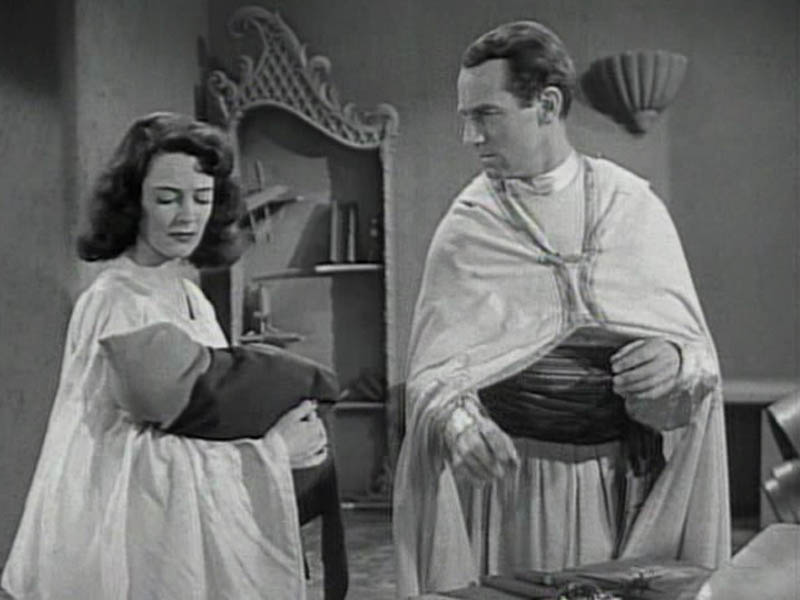
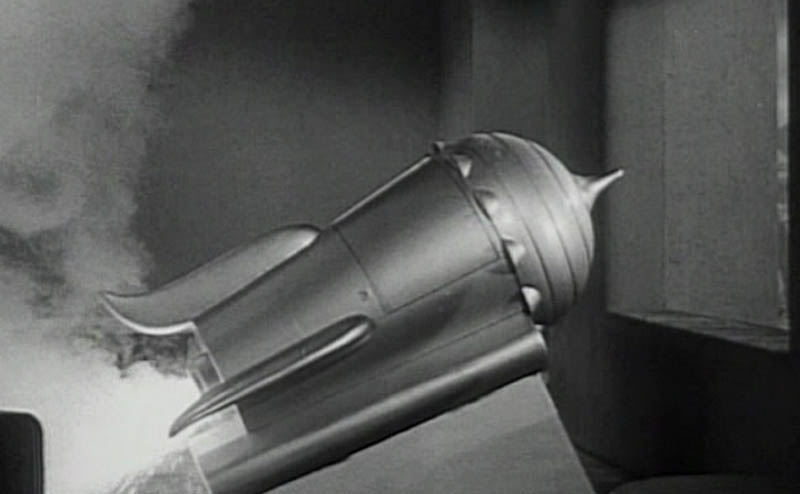
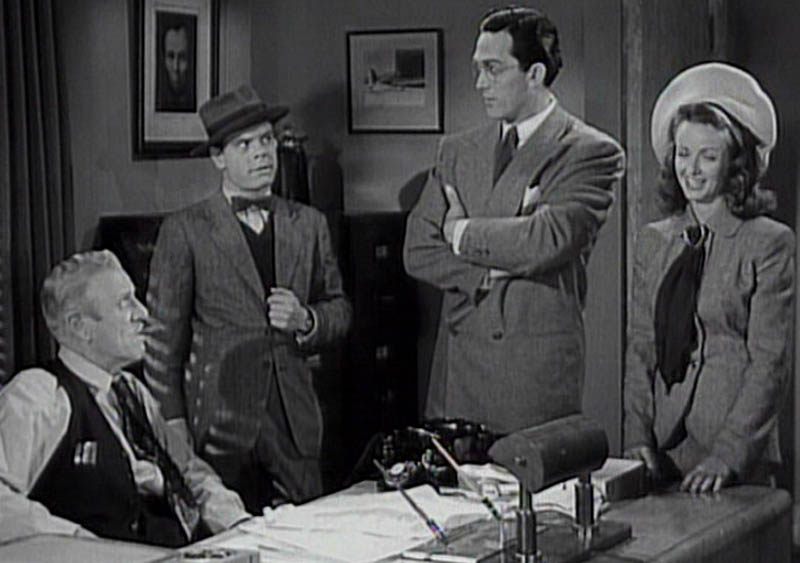
-
In 1948, Kirk Alyn (1910-1999) became the face of Superman, while Noel Neill (b. 1920) first assumed the role of Lois Lane. The first 15-part serial, entitled simply Superman, concerned a villainess called the Spider Woman (inspired by the Scarlet Widow from The Adventures of Superman radio program), her search for
kryptonite, and her ensuing struggle for world domination.

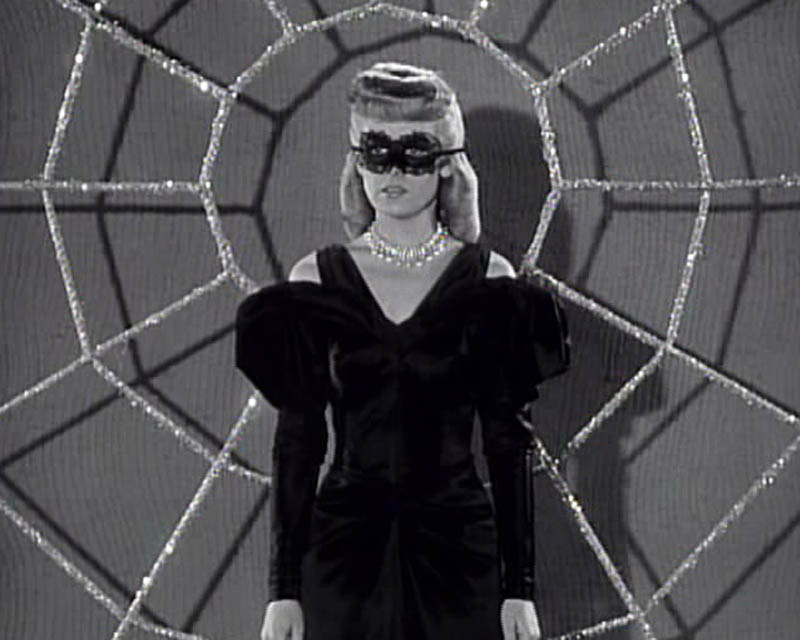
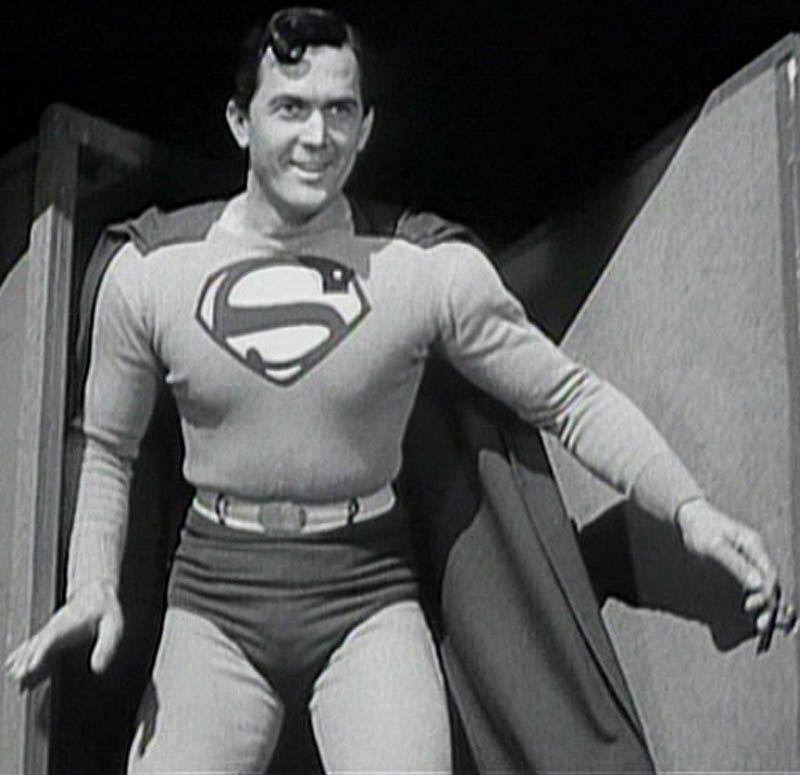
Atom Man vs. Superman
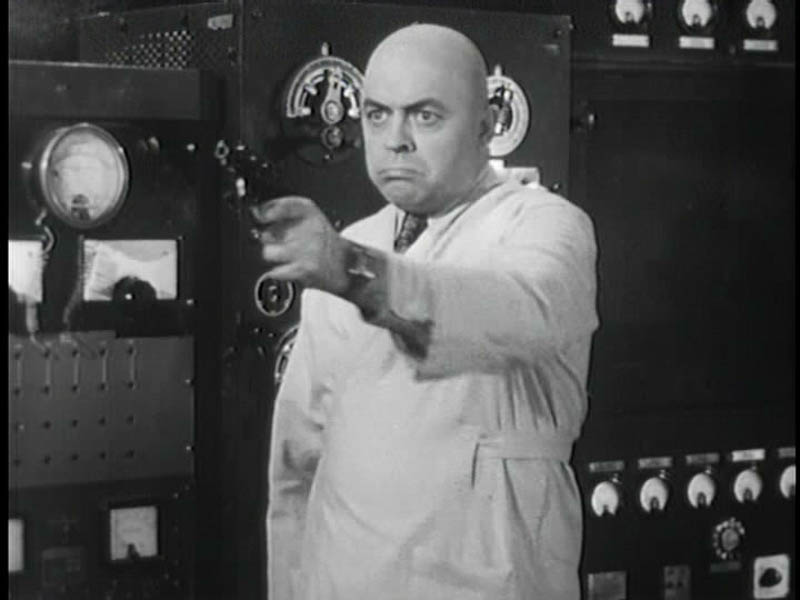
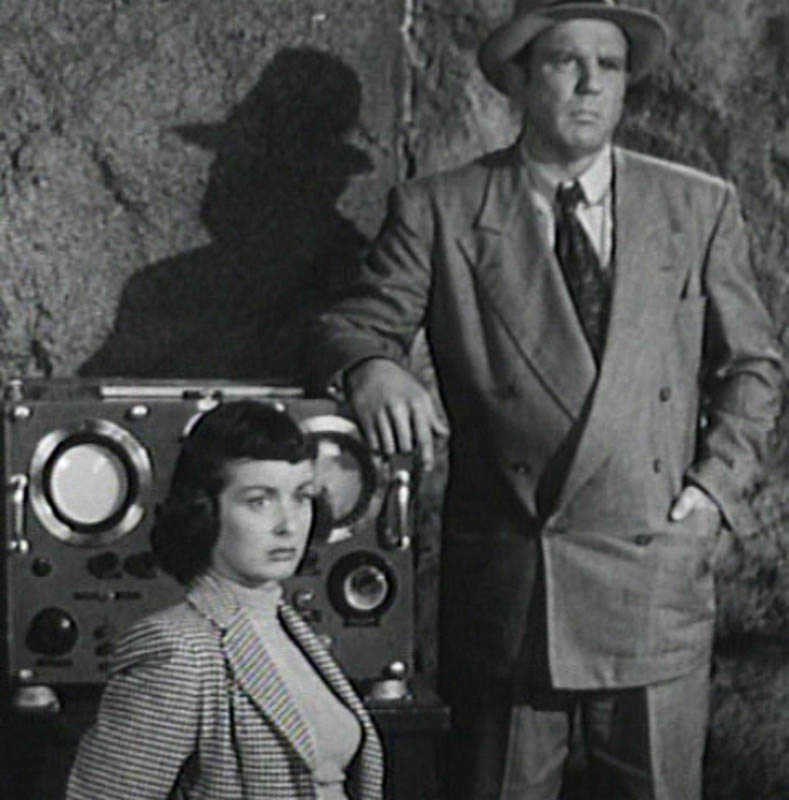

-
The second serial, Atom Man vs. Superman (1950), recounts a tale of how Luthor, as the Atom Man, using a teleporter and synthetic kryptonite, attempts to best
the Man of Steel. This was Luthor’s first appearance in a medium apart from the comics.
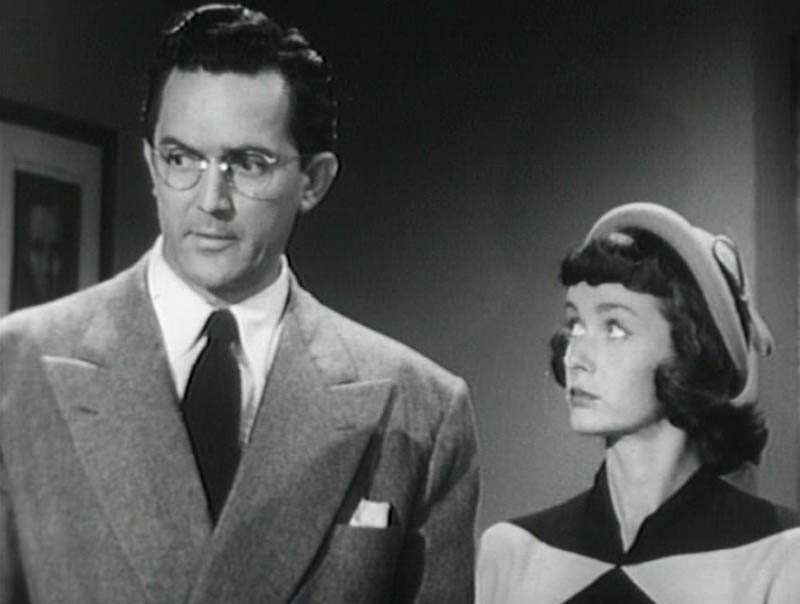
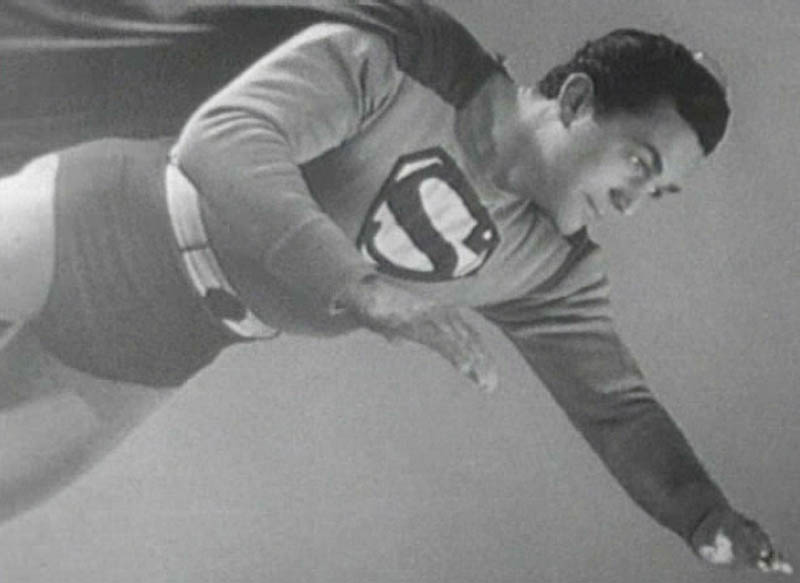
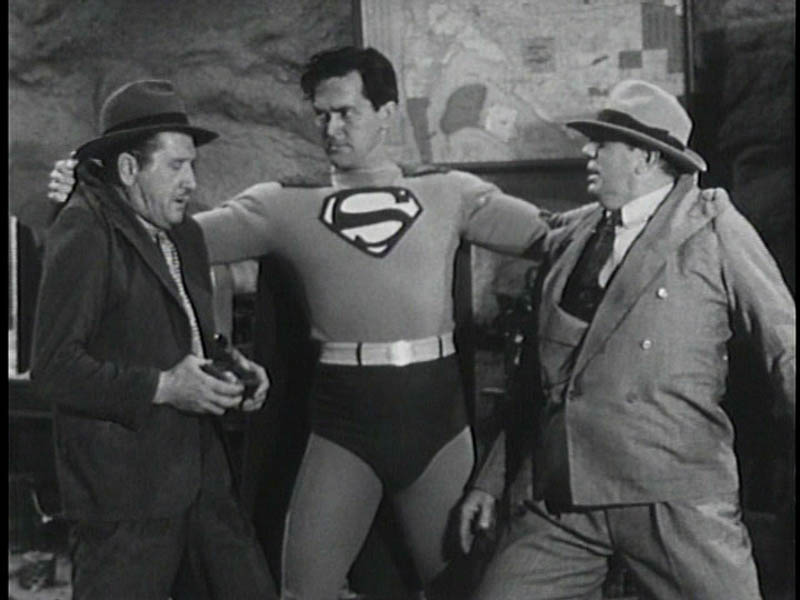
-
Atom Man vs. Superman is widely considered the most successful movie serial of all-time.
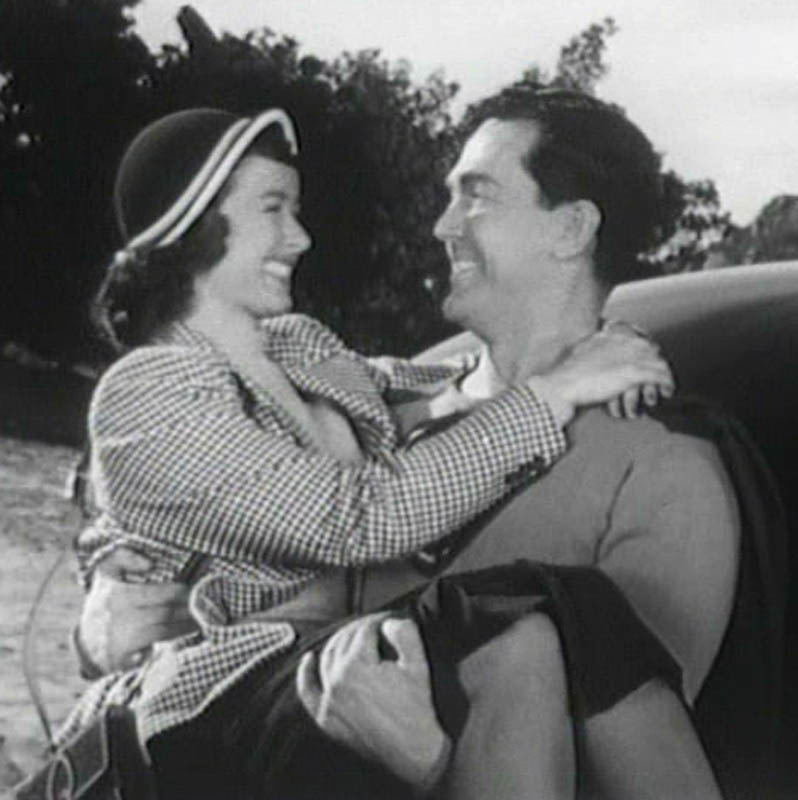
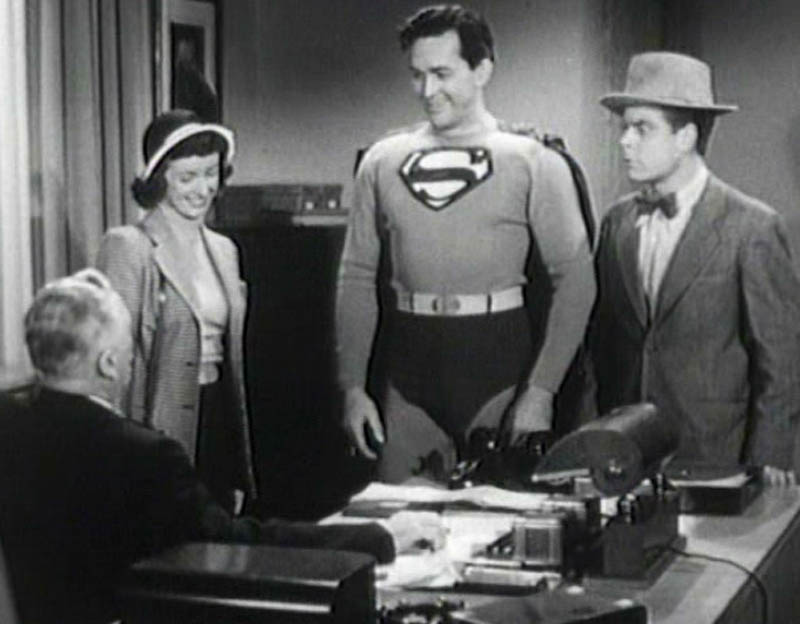
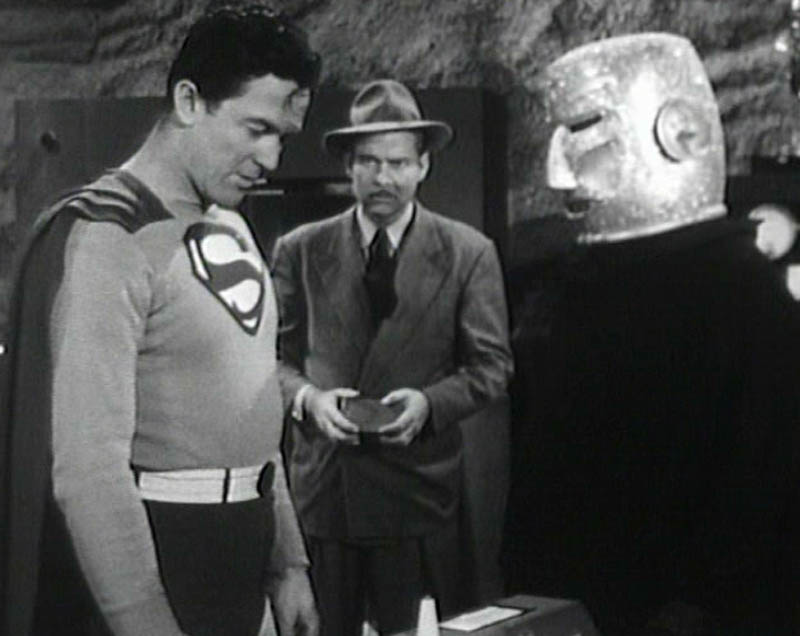 The source of dramatic tension in the movie serials, quite the opposite from the radio serial, is overwhelmingly (and cliffhangingly) the need to rescue Lois from
physical danger. In order, the remaining sources of conflict are the need to save Jimmy, physical danger to Superman himself, and, finally, threats of revealing
Superman’s secret identity. All of the actors deliver adequate performances. The music and special effects are both inferior to those produced in the
Adventures of Superman television series a few years later. Nevertheless, as Superman’s first live-action appearance, the Superman serials with
Kirk Alyn remain a classic and a hallmark in the history of film and super-heroes.
The source of dramatic tension in the movie serials, quite the opposite from the radio serial, is overwhelmingly (and cliffhangingly) the need to rescue Lois from
physical danger. In order, the remaining sources of conflict are the need to save Jimmy, physical danger to Superman himself, and, finally, threats of revealing
Superman’s secret identity. All of the actors deliver adequate performances. The music and special effects are both inferior to those produced in the
Adventures of Superman television series a few years later. Nevertheless, as Superman’s first live-action appearance, the Superman serials with
Kirk Alyn remain a classic and a hallmark in the history of film and super-heroes.
Superman of the Adventures of Superman Television Series
First Season
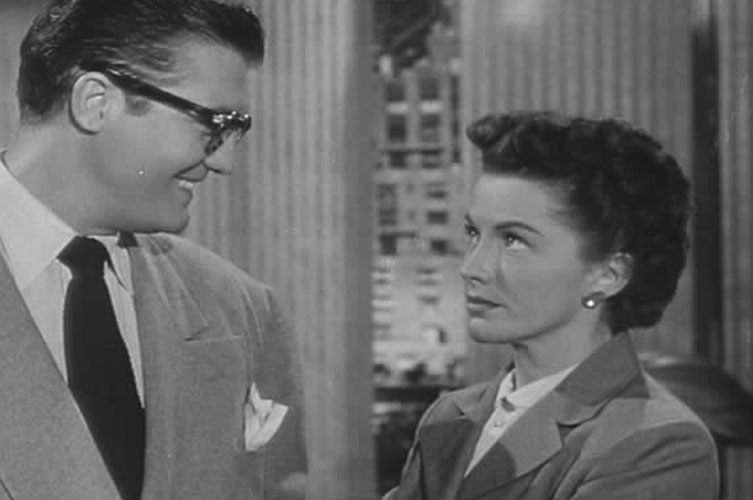

With George Reeves (1914-1959) as the Metropolis Marvel beginning in 1952, the Adventures of Superman television series was as integral to the Golden
Age of television as the same-named radio serial was to radio. Reportedly a low-budget production even for the time, with its principal actors underpaid
(with the possible exception of Reeves himself), the series nevertheless rapidly became a hit, with children as the primary audience. After the studio
recognized who their audience was, plots and scripts were “dumbed down” to reflect the perceived sensibilities of the viewers.
Fourth Season
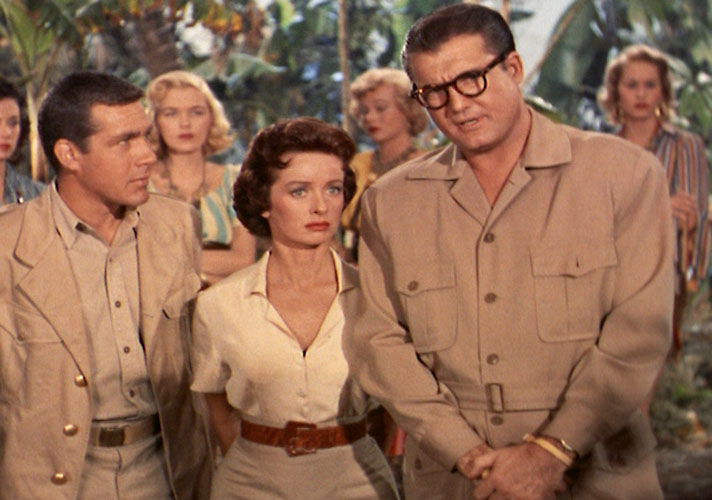
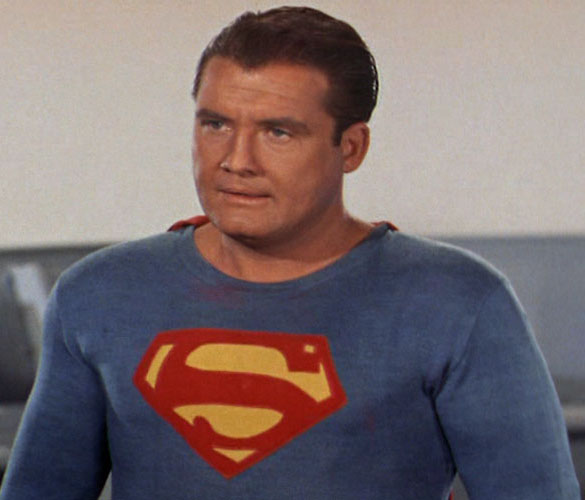
Phyllis Coates (b. 1927) portrayed immortal reporter Lois Lane in the first season of the show.
Noel Neill reprised the role of Lois Lane beginning in the second season and remained until the cancellation of the series in 1958.
This incarnation of the Caped Kryptonian had adoptive parents named Eben and Sarah Kent. The series never in its six seasons used a villain from the
comics, although kryptonite was a common plot device. Like the radio show before it, Superman’s adventures tended to be realistic, and he faced
down-to-earth, run-of-the-mill criminals and thugs. However, the plots in the sixth and final season incorporate many fantastic elements, including
a diminutive Martian who may have been a nod to Mxyzptlk.
When George Reeves died from a gunshot wound, the nation reacted with shock. It was as if Superman himself had died.
Hollywoodland
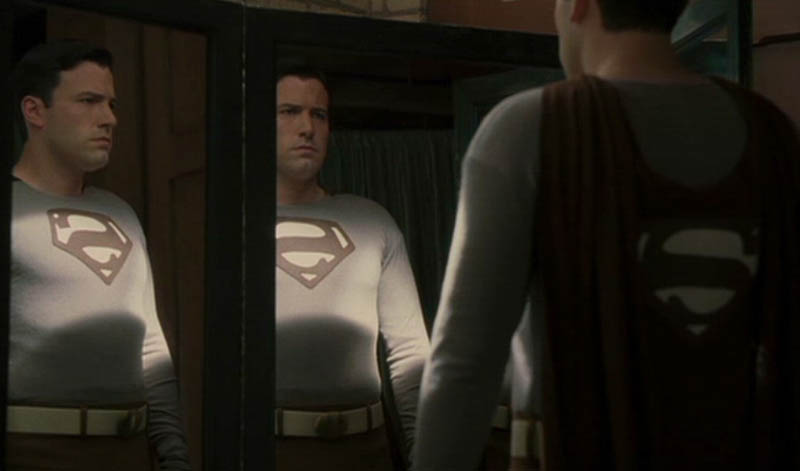
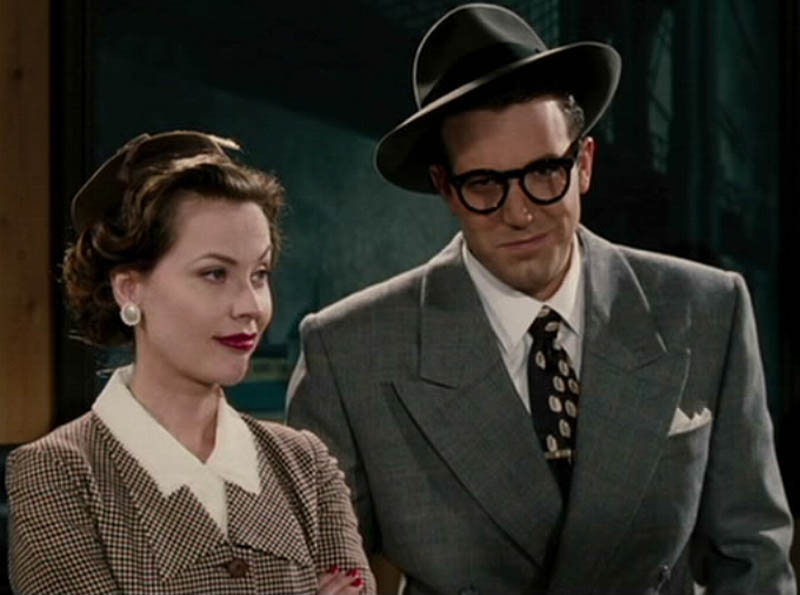
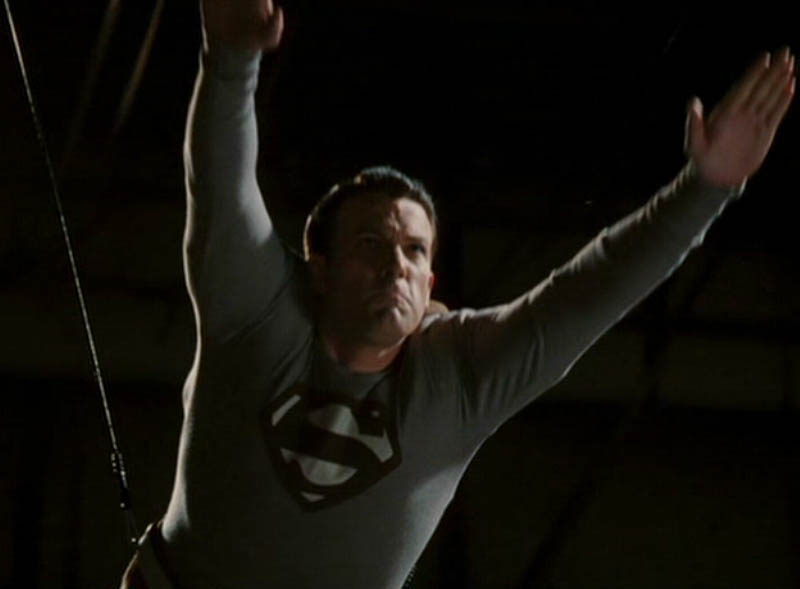 The 2006 film Hollywoodland, which was directed by Allen Coulter (who also directed eight episodes of Sex & the City & 12 of
The Sopranos), recounts Reeves’ life and presents three possible versions of his death. The film purports to historical accuracy but
falls short in many respects. First, the private investigator is admittedly fictitious. Second, the film exhibits no less than three urban legends as
bona fide incidents in George Reeves’ life: his encounter with a boy wielding a loaded gun wanting to see bullets bounce off him, the
implication that some of his screen time in From Here to Eternity was cut from the released version due to audience reaction to a screening
(which never, in fact, occurred), and a misquote of Reeves’ fiancee, Leonore Lemmon, moments before his shooting—“He’s going to shoot
himself.” Another confusing incident in the film shows Reeves (played by Ben Affleck) burning the Superman costume on a grill claiming
Adventures of Superman was cancelled. Yet both Noel Neill and Jack Larsen have stated Adventures of Superman was renewed for a seventh season.
The 2006 film Hollywoodland, which was directed by Allen Coulter (who also directed eight episodes of Sex & the City & 12 of
The Sopranos), recounts Reeves’ life and presents three possible versions of his death. The film purports to historical accuracy but
falls short in many respects. First, the private investigator is admittedly fictitious. Second, the film exhibits no less than three urban legends as
bona fide incidents in George Reeves’ life: his encounter with a boy wielding a loaded gun wanting to see bullets bounce off him, the
implication that some of his screen time in From Here to Eternity was cut from the released version due to audience reaction to a screening
(which never, in fact, occurred), and a misquote of Reeves’ fiancee, Leonore Lemmon, moments before his shooting—“He’s going to shoot
himself.” Another confusing incident in the film shows Reeves (played by Ben Affleck) burning the Superman costume on a grill claiming
Adventures of Superman was cancelled. Yet both Noel Neill and Jack Larsen have stated Adventures of Superman was renewed for a seventh season.
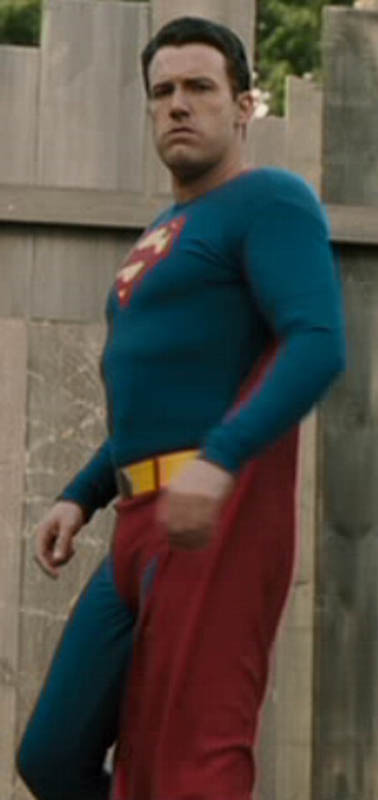
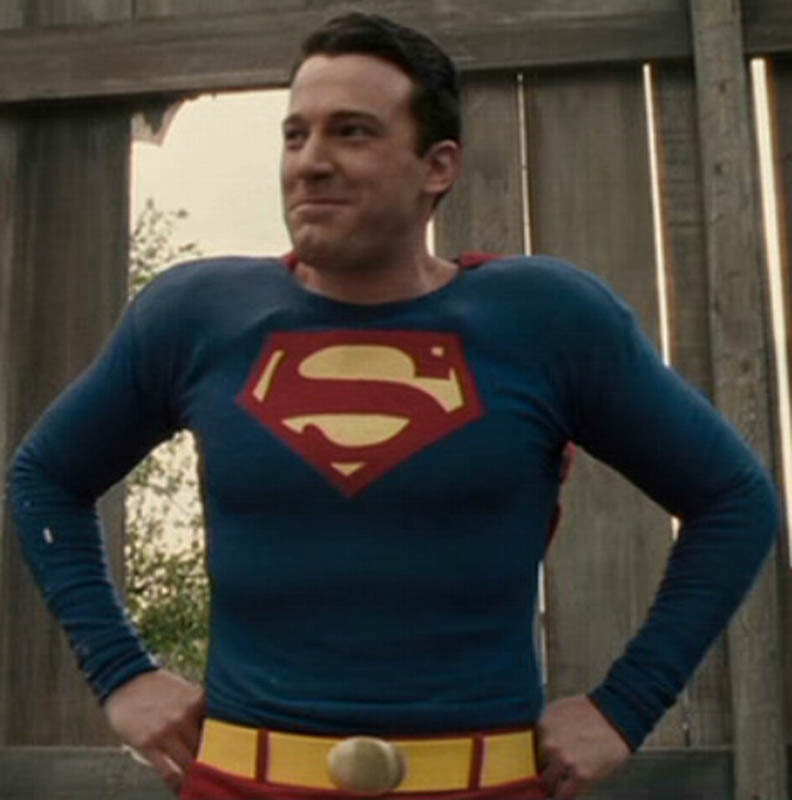
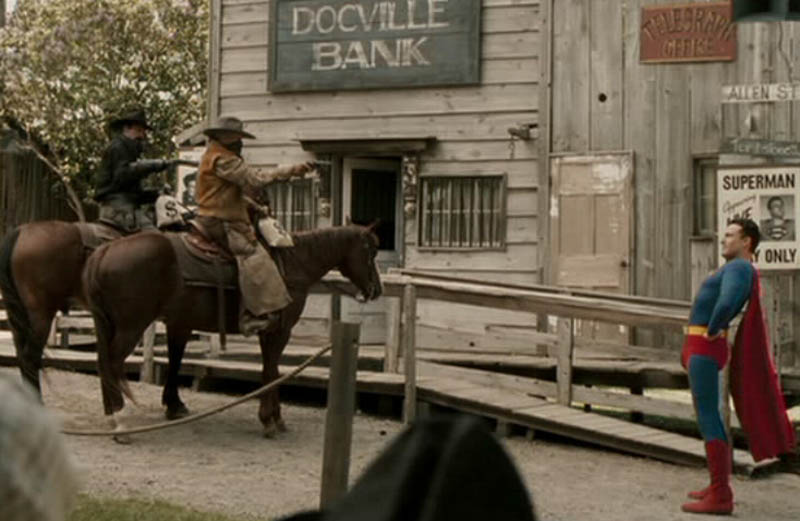
Silver Age Superman
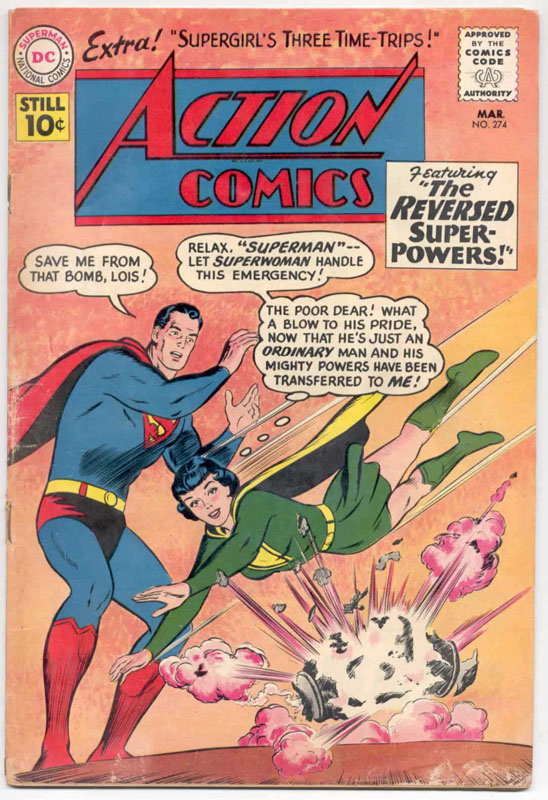


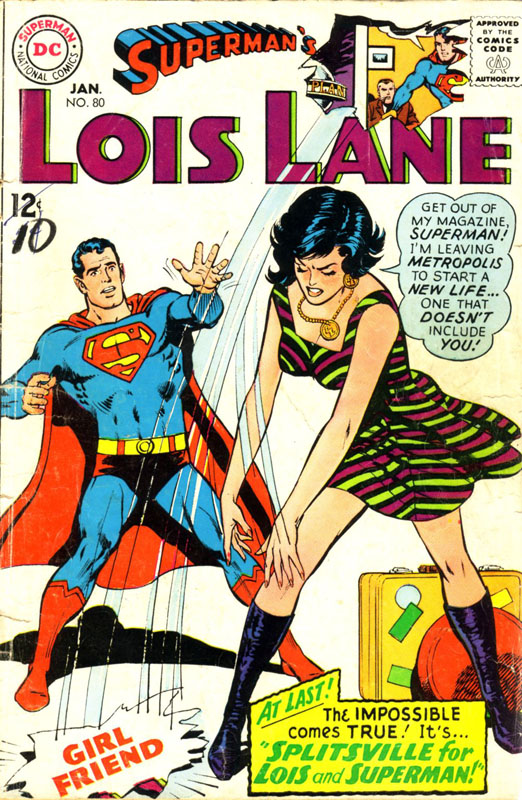
When the transition between the Golden and Silver Ages occurred is hotly debated. Superboy first appeared in 1945; so some would draw the line there.
In 1956, the Silver Age Flash first appeared; so some claim that the 1956 Man of Tomorrow must be the Silver Age one as well. (There is no ambiguity
pertaining to the versions of the Flash, as each had a distinct costume, secret identity, and origin story.) Still others claim 1958 as the crucial year,
because Brainiac and Bizarro, two hallmark villains of the Silver Age, both appeared then. Whenever the shift occurred, in 1961 the Flash discovered that
the two Flashes were actually from different but parallel worlds—the Silver Age Flash from Earth-1 and the Golden Age speedster from
Earth-2—and that travel between the two worlds was possible. In 1969, Superman discovered he too had an Earth-2 analogue in the person of the
Golden Age Superman.
The chief differences between the two Men of Steel are that the Silver Age Superman is stronger, smarter, and more powerful. Although the Golden Age Man
of Tomorrow possesses heat vision, the power did not receive its proper name until the Silver Age. In addition, the Silver Age Action Ace acquires
super-touch in Action Comics #227 (Apr 1957), and, in February 1959 (Superman #127), the writer reveals that his telescopic vision can peer
into the distant past.
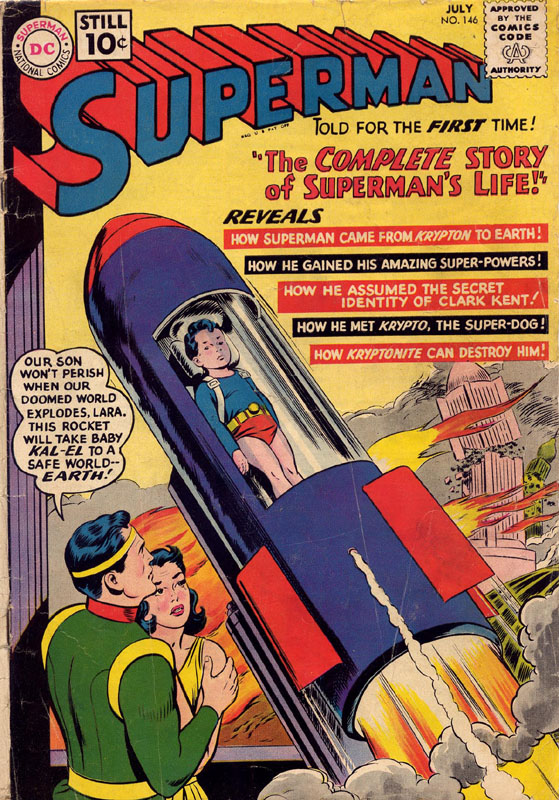
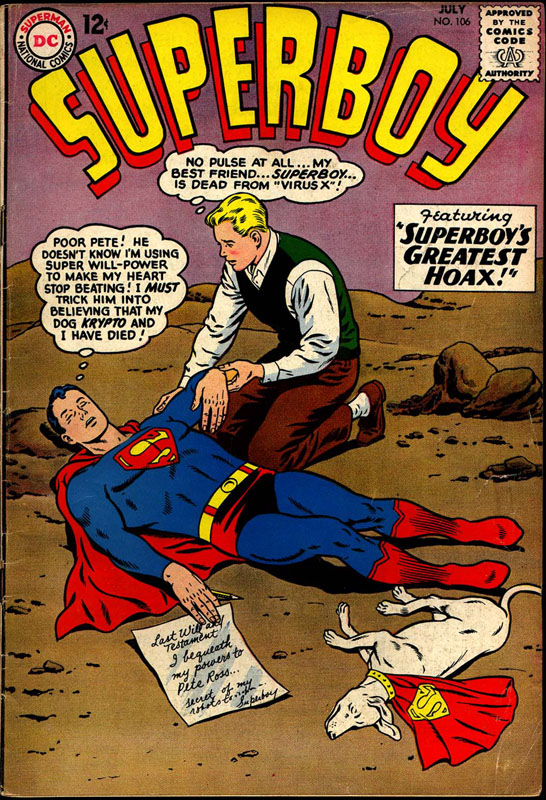

Arriving on Earth as a baby, the young Kal-El of Earth-1 is adopted by Jonathan and Martha Kent, the kindly couple who found his spacecraft. As
Clark Kent grows and discovers his powers, he adopts the identity of Superboy. Clark’s awesome powers receive a new explanation in
Action Comics #262 (1960). His abilities are now said to derive from Earth’s yellow sun and not from the advanced state of Kryptonian evolution.
Superboy has access to the learning machine sent by his biological father, Jor-El, and other advanced Kryptonian technology and is soon constructing robots
and other devices. Clark’s adoptive parents, Ma and Pa Kent, fall ill and die shortly before Clark changes his super-heroic identity’s name from Superboy
to Superman. Superboy receives two cast members to act as surrogates for Superman’s companions Lois Lane and Jimmy Olsen in the form of Lana Lang (1950)
and Pete Ross (1961). The adult Clark becomes a reporter for the Daily Planet newspaper under the editorship of Perry White.
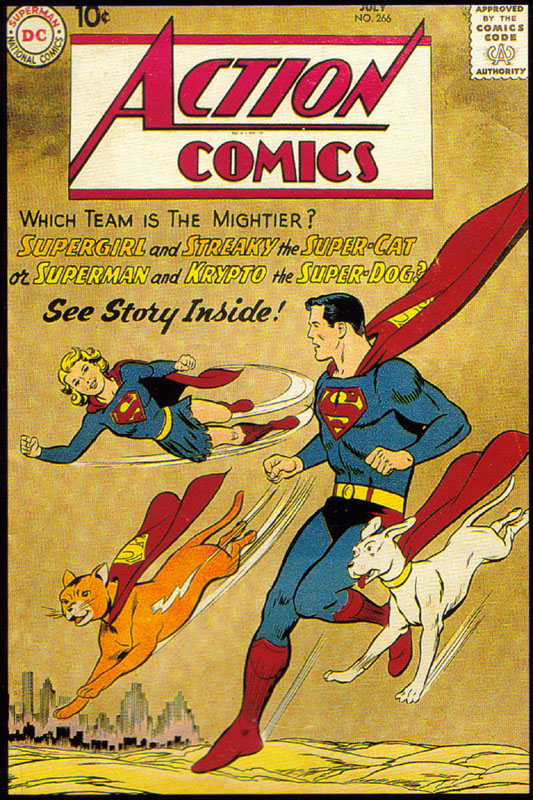

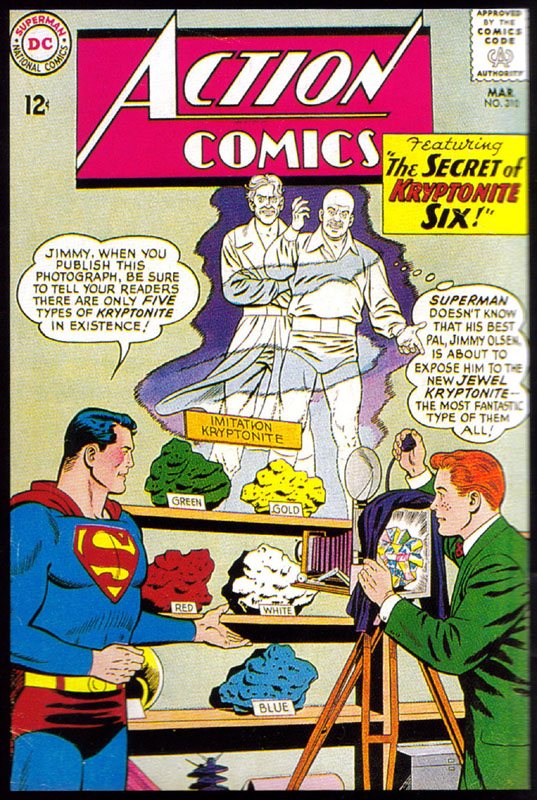

Many other survivors of Krypton besides Superman himself arrived during the Silver Age: Kal-El’s dog Krypto (1955), his cousin Supergirl
(1959), and a plethora of extraterrestrial criminals banished to the wraith-like state of the Phantom Zone, coincidentally invented by Superman’s father,
Jor-El.
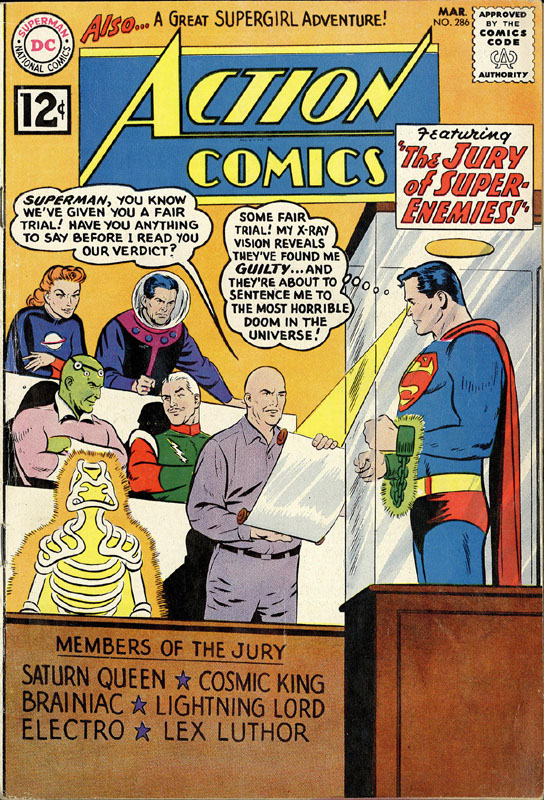
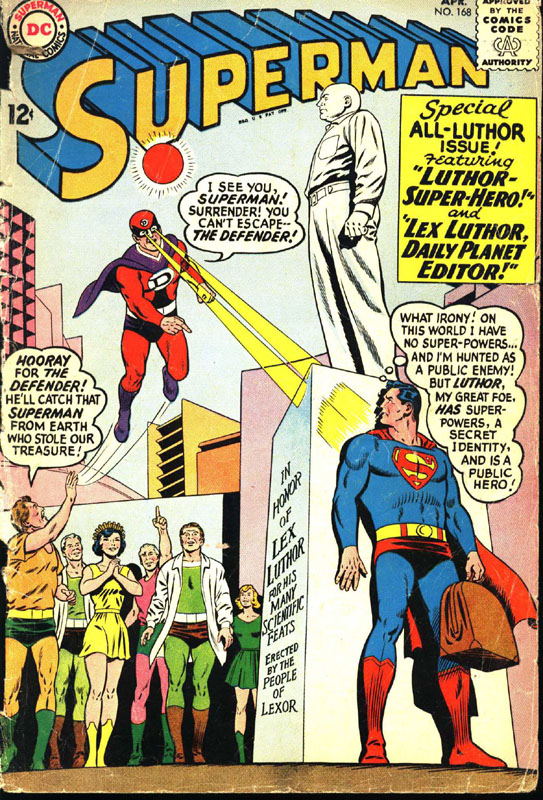
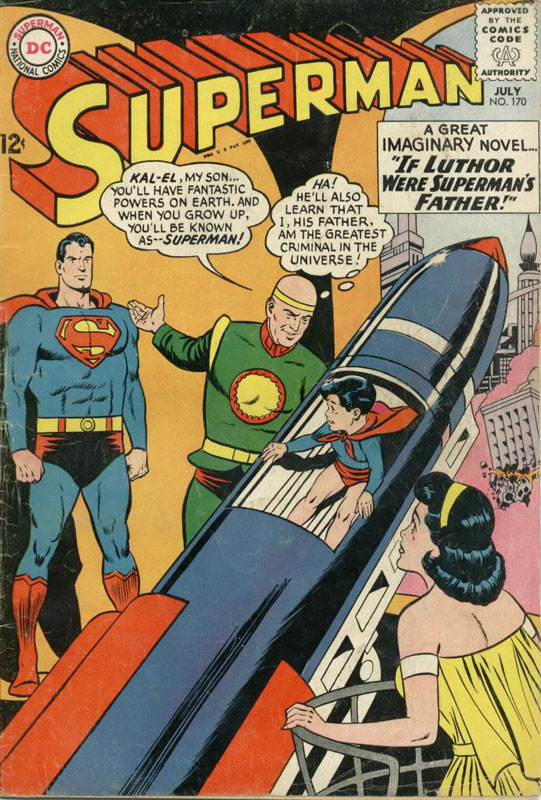
In 1962, the story of the Luthor of Earth-1 received some embellishment. The comics reveal that his hitherto unuttered first name is Lex, that he
grew up in Superboy’s hometown of Smallville, was in fact friends with both Clark and the Boy of Steel, and had red hair until a lab accident caused both
his baldness and his animosity for Superboy.



The Silver Age Mr Mxyzptlk received a makeover in the form of the transposition of the ‘t’ in his name to its more familiar position, a more
exotic orange costume (as opposed to his earlier purple suit), and some tufts of white hair.
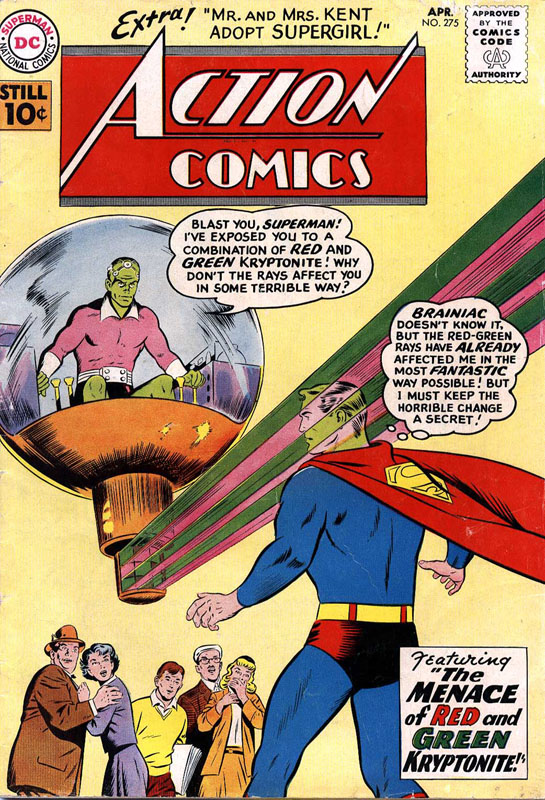
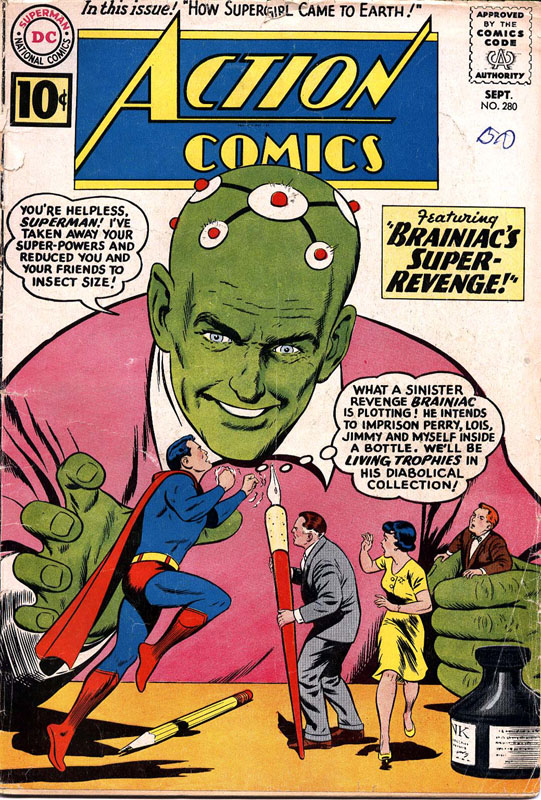
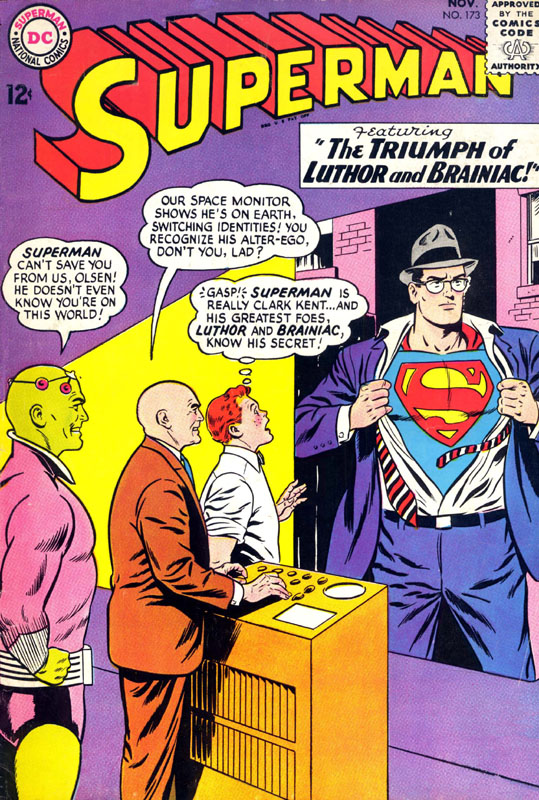
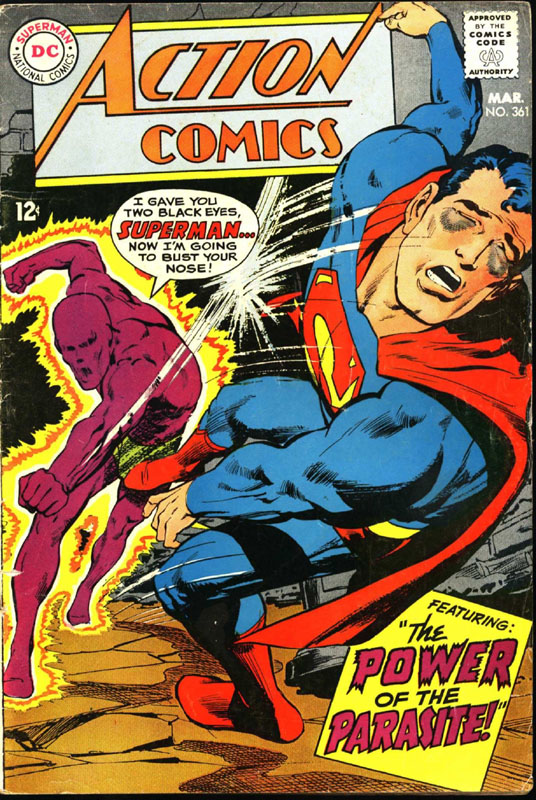
Superman’s rogues gallery bloomed in the Silver Age with the addition of such worthies as Brainiac (1958), Bizarro (1958), Metallo (1959),
Ultraman (1964), and the Parasite (1966).
Superboy’s list of allies increased by a significant three in 1958 (Adventure Comics #247), when he met the Legion of Super-Heroes.
Curt Swan (1920-1996) was the most prolific Superman penciller of the Silver & Bronze Ages. Swan pencilled all of the covers displayed in this section
with the exception of World’s Finest #123 (Dick Dillin) & Action Comics #361 (Neal Adams).
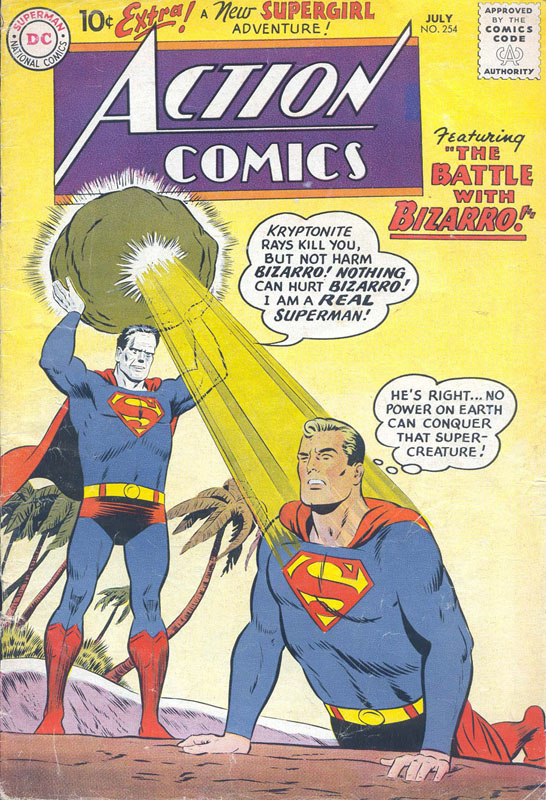


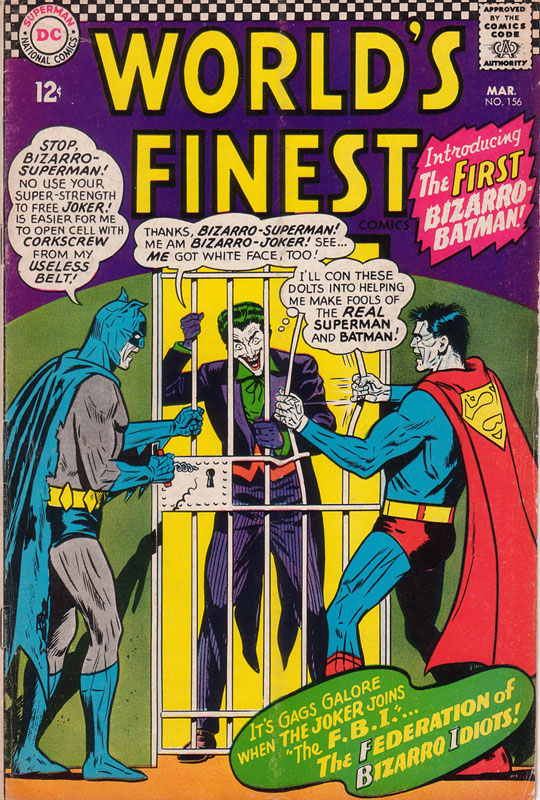
The Bizarro Superman was literally a copy of the Man of Steel. Professor Dalton created the original Bizarro with his duplicating ray, which proved to
create imperfect duplicates, in Superboy #68; Bizarro was destroyed in the same issue. Years later, Luthor re-created the duplicating ray and Bizarro
by using the ray on the adult Superman. Bizarro has the same powers as Superman, except that some of them are reversed, such as cold vision and fire
breath. Likewise, Bizarro is as intelligent as Superman, but his thinking and logic are often reversed. This leads the creature to cause problems even
though his intentions are good.
Ultraman

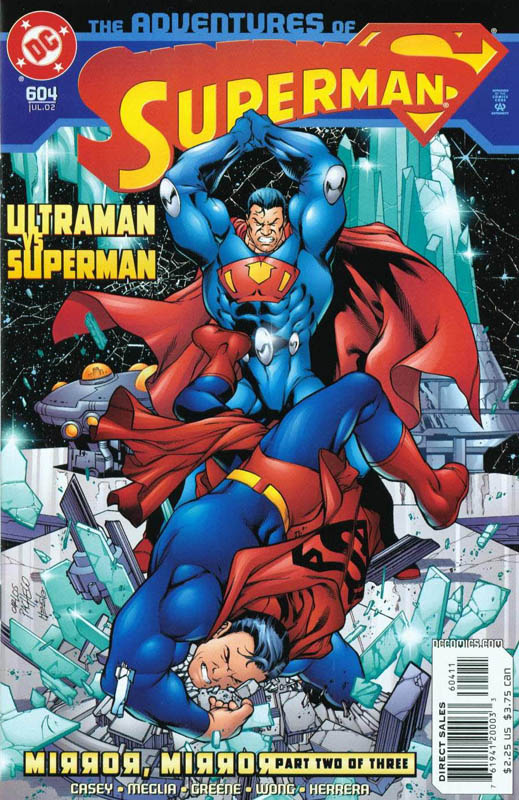

Ultraman is the evil Kal-El of Earth-3 (or Qward, the antimatter universe). He is a member of the Crime Syndicate of AmeriCa along with such villains
as Superwoman (an evil Wonder Woman), Owlman, Power Ring (Green Lantern), &
Johnny Quick (the Flash). His powers are the same as Superman’s but his power source and vulnerabilities are sometimes reversed.
Superman of the 1966-1970 Filmation animated TV series The New Adventures of Superman
The New Adventures of Superman (1966-1970)

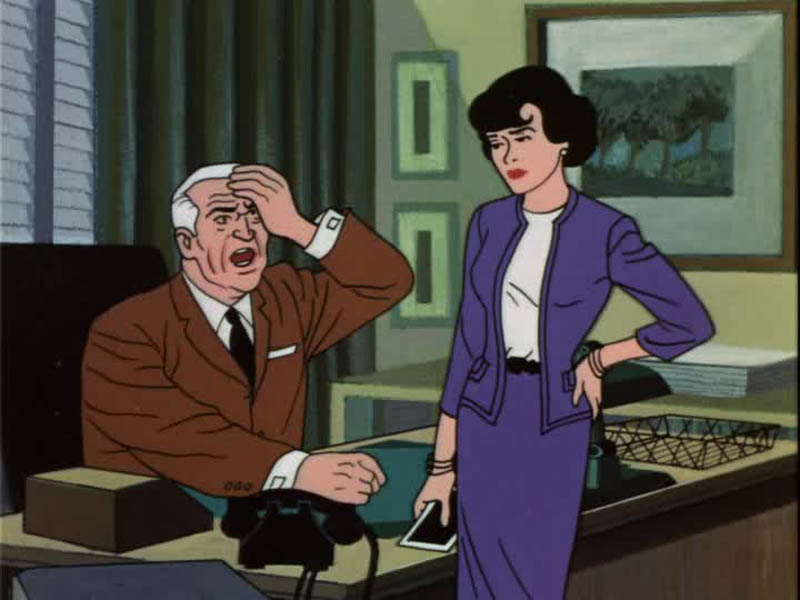
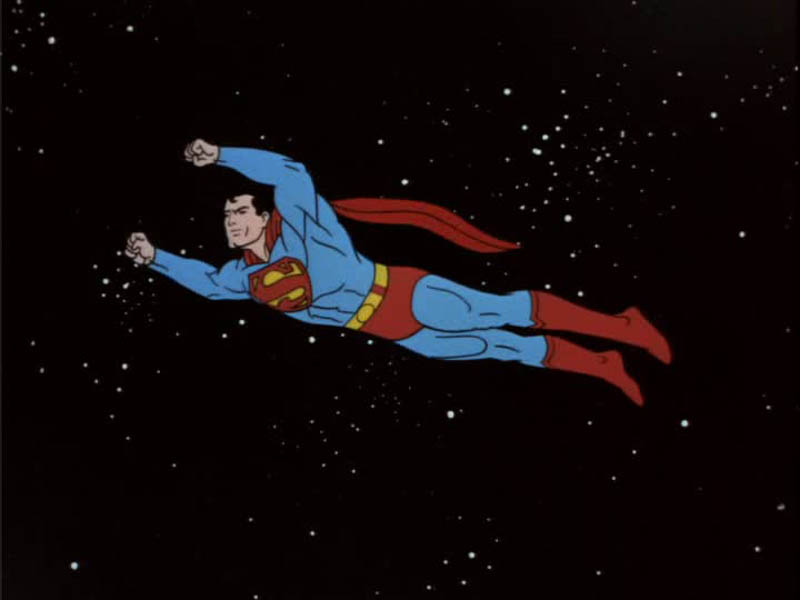
-
In the sixties, Filmation produced 68 six-minute Superman cartoons, which aired on CBS on Saturday morning from 1966 to 1970.

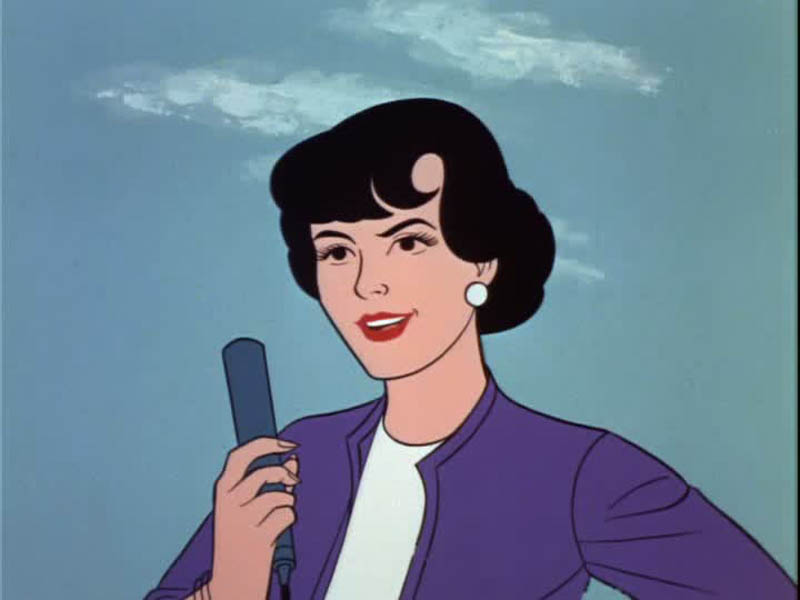

-
The New Adventures of Superman aired in three slightly differently packaged programs over that time.
- The first season, which premiered September 10, 1966 was a 30-minute program featuring two The New Adventures of Superman animated shorts & one
The Adventures of Superboy cartoon.
- The second season, which premiered September 9, 1967 was a 60-minute program whose format varied from episode to episode. The show featured both new
The New Adventures of Superman & The Adventures of Superboy animated shorts in addition to 36 Aquaman shorts & three shorts each featuring the
Flash, Green Lantern, Hawkman, the Atom, the Justice League of America, & the Teen Titans. This marked the first appearance in animation of any of these characters,
except Superman (who had appeared in the Fleischer/Famous theatrical shorts of the 1940s in addition to the first season of The New Adventures of Superman)
& Superboy (who had appeared in the first season of The New Adventures of Superman).
- The third season, which premiered September 14, 1968 was a 60-minute program featuring new The New Adventures of Superman & The Adventures of Superboy
segments alongside animated shorts featuring—in their animated debut—Batman, Robin, & Batgirl.
- The fourth season, which premiered September 13, 1969 was a 30-minute program in the same format as the first season, which featured re-runs of previously-aired
episodes of The New Adventures of Superman & The Adventures of Superboy.


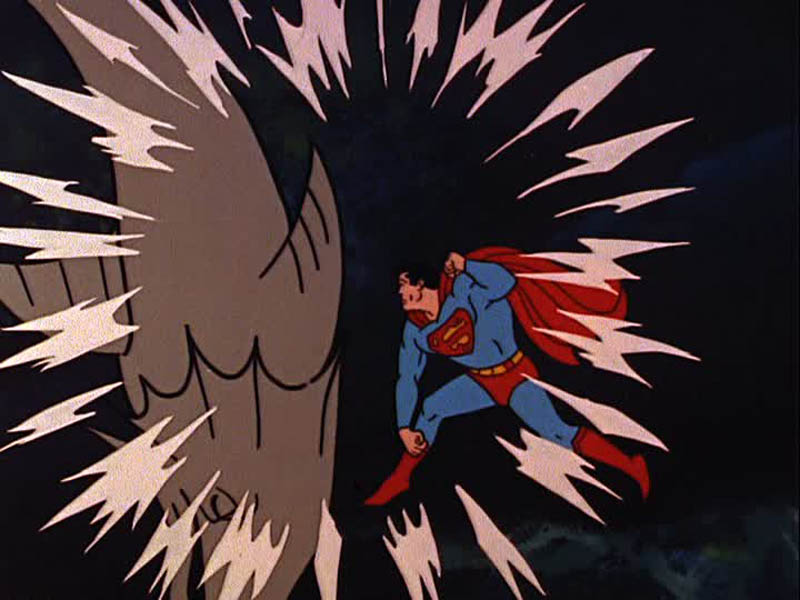
-
The New Adventures of Superman is notable for its voice cast & production crew. Bud Collyer reprised the voice role he had originated in
The Adventures of Superman radio serial as well as the first seven Fleischer animated, theatrical Superman shorts. Joan Alexander (the voice of Lois Lane in
The Adventures of Superman radio serial & the Fleischer cartoons) voiced Lois in the first season of The New Adventures of Superman. Jack Grimes,
who had voiced Jimmy Olsen on The Adventures of Superman radio show from 1949 to 1951, reprised that role. Jackson Beck, the announcer on
The Adventures of Superman radio program from 1943 to 1951, voiced Perry White on The New Adventures of Superman.
- In addition to the show’s voice cast, Bob Haney & George Kashdan—comic writers at DC at the time—wrote many of the shorts, while Mort Weisinger,
editor of all of the Superman titles, also served as script editor on all of the Superman & Superboy cartoons. Furthermore, the art style & character design of the show
intentionally mimics the artistic style of the legendary Curt Swan.
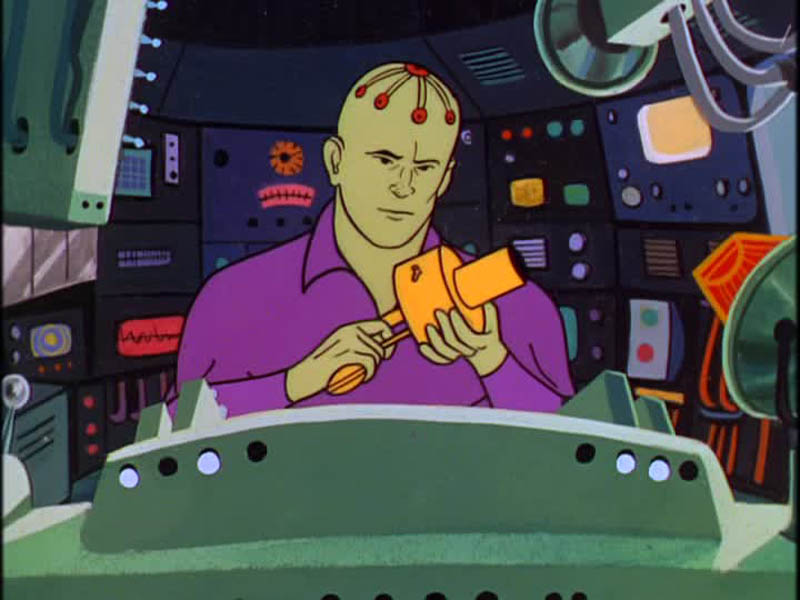
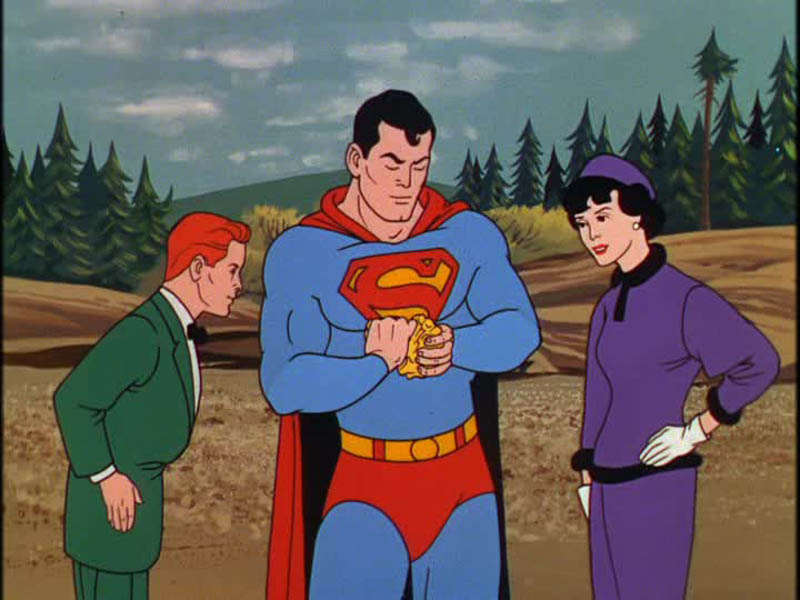

-
The New Adventures of Superman also marked the first TV & animated appearances of Jimmy Olsen, Lex Luthor, Brainiac, Mr Mxyzptlk, the Parasite, Titano,
the Toyman, & the Prankster.
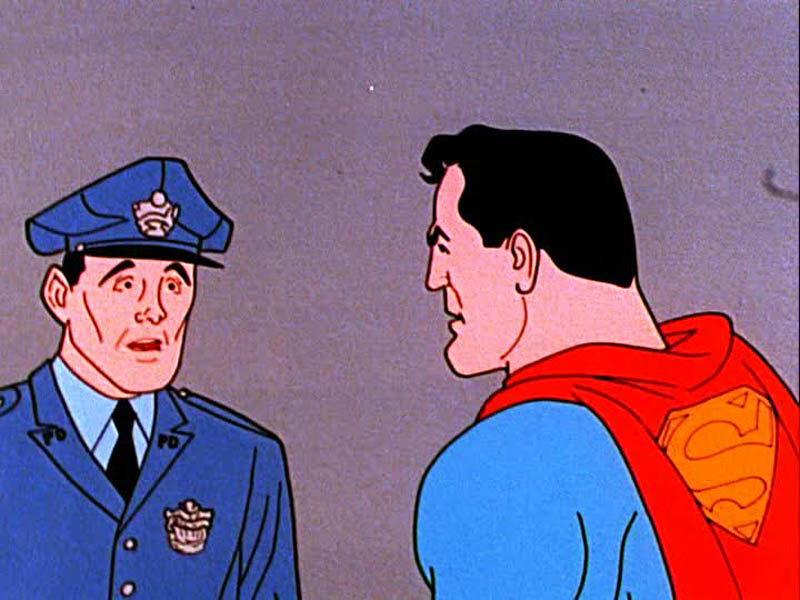
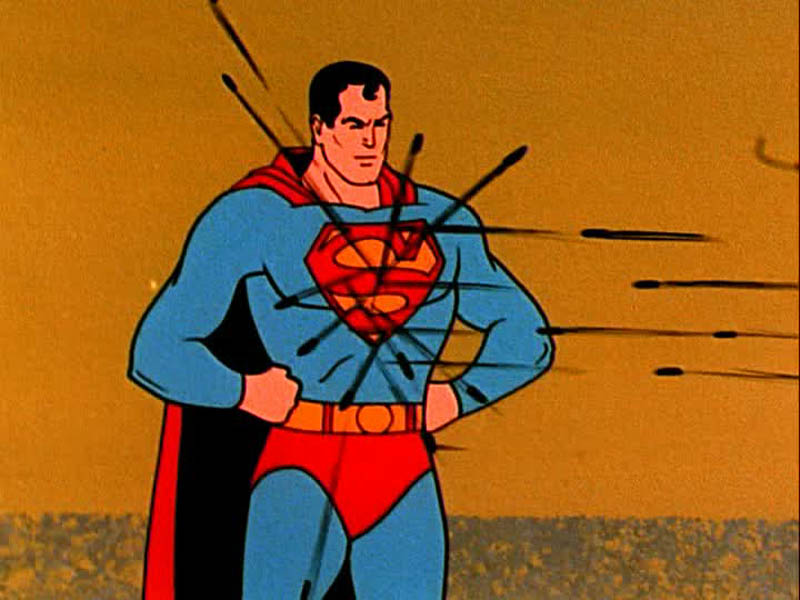
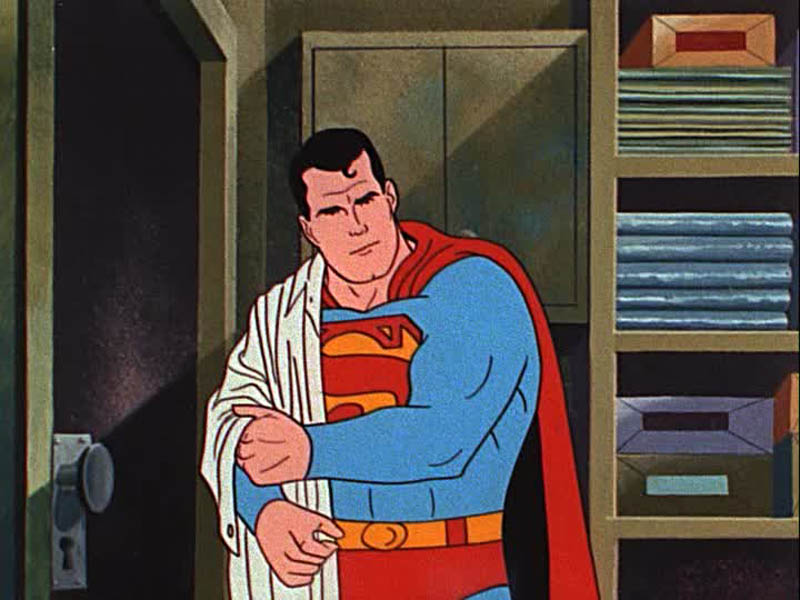
The Adventures of Superboy (1966-1970)

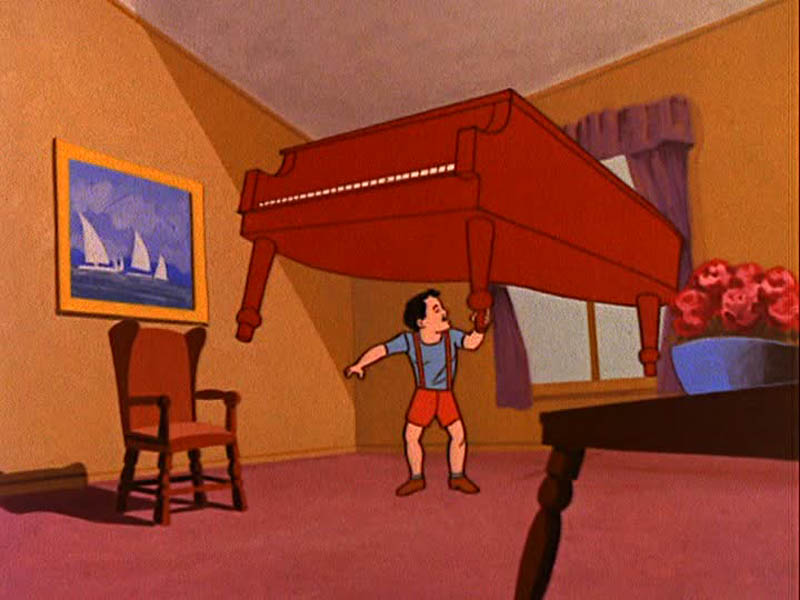
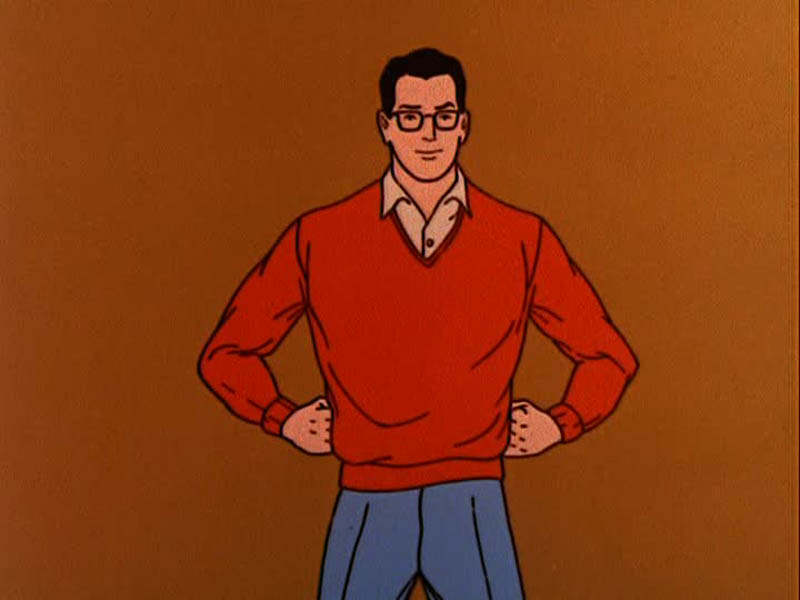
-
Filmation produced 34 six-minute Superboy cartoons as part of The New Adventures of Superman package. The Adventures of Superboy is
notable as both the television & animated debut of Superboy, Lana Lang, & Krypto. Additionally, it was the animated premiere for Ma & Pa Kent.
Bob Hastings (The Super Friends, Batman: The Animated Series, Sgt Bilko, McHale’s Navy) provided the voice of
Superboy/Clark Kent, Janet Waldo (who portrayed Judy Jetson, Josie on Josie & the Pussycats, & the Princess on Battle of the Planets
in addition to a one-time guest role on Thundarr the Barbarian) played Lana, & Ted Knight (The Super Friends, The Mary Tyler Moore Show,
Caddyshack, Too Close for Comfort) served as the narrator.

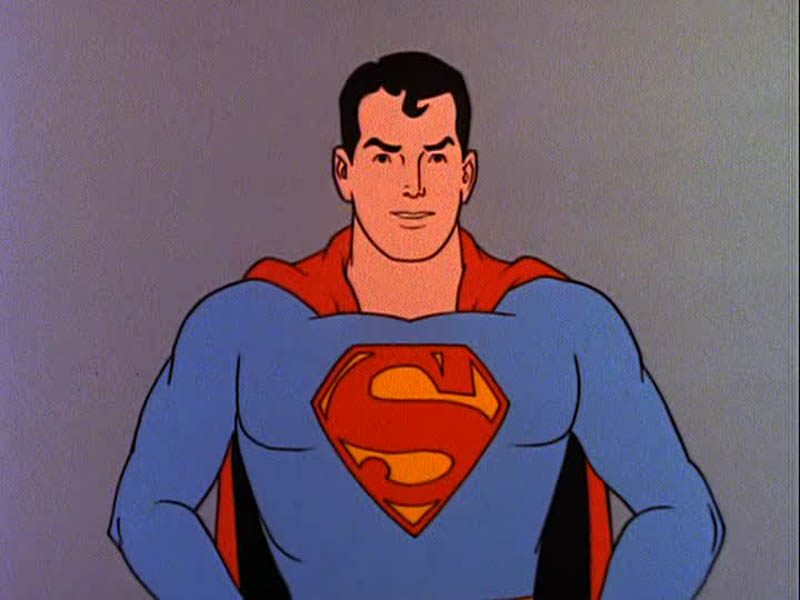
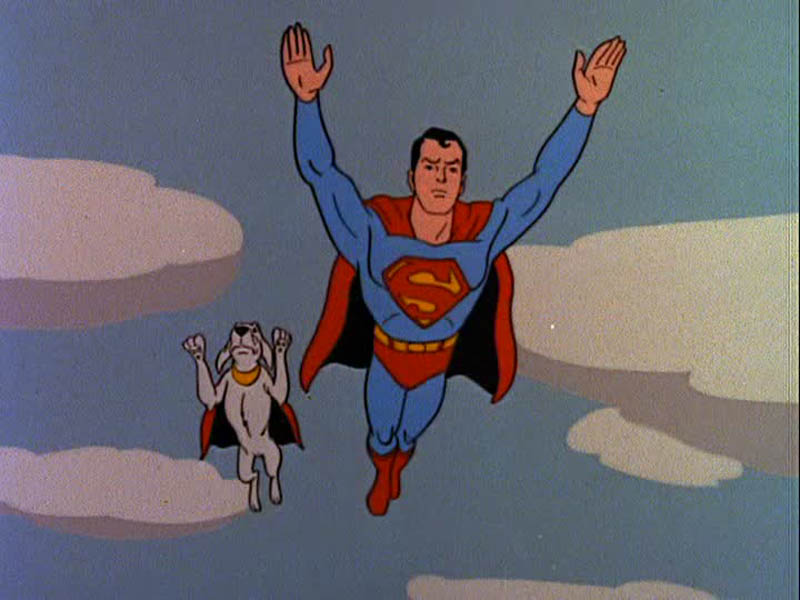
Bronze Age Superman
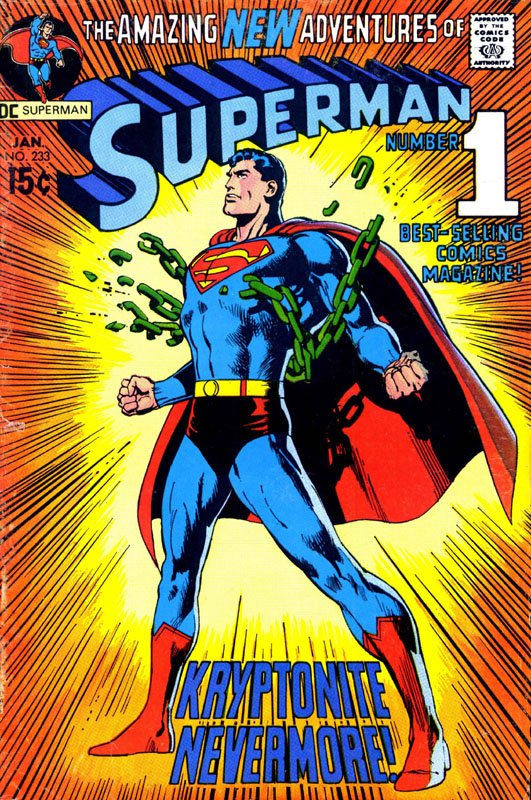
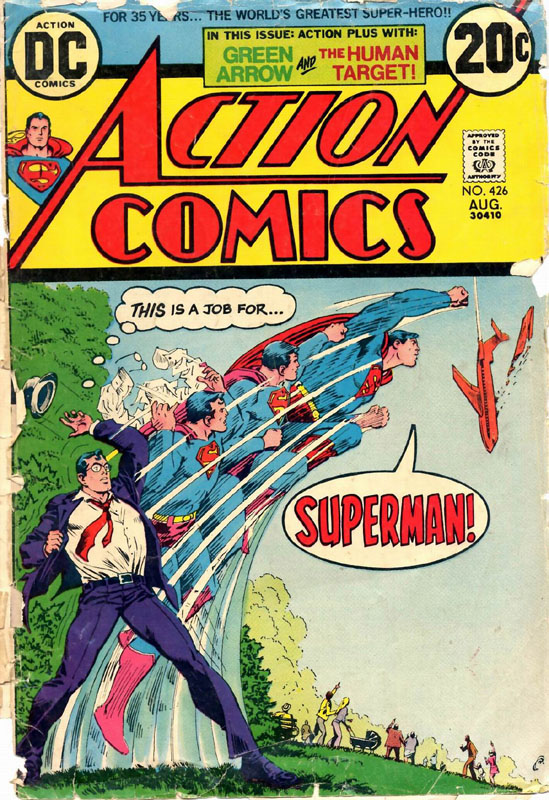

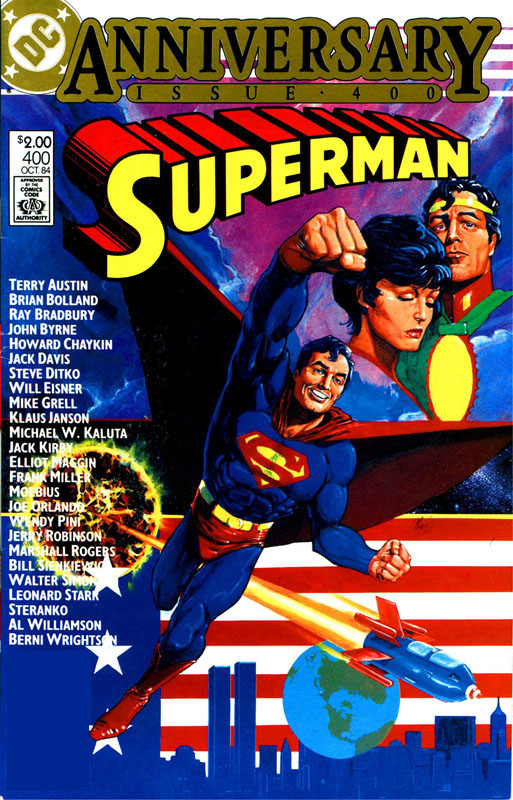
The time of this division is as arbitrary as the time of the previous delineation of eras. However, most people name 1971 as the year when the shift
happened. The two pivotal events of 1971 were Julius Schwartz’ (1915-2004) assumption of the role of editor of Superman from Mort Weisinger (1915-1978), and
DC Comics’ acquisition of legendary comic artist Jack Kirby (1917-1994) from Marvel Comics. Jack Kirby quickly created the New Gods and Darkseid, characters of
vast importance to the Superman mythos from then onward. Julie Schwartz allowed writers to modernize the Man of Steel and his alter ego by experimenting
with the destruction of all kryptonite on Earth, lessening the power levels of the Man of Tomorrow, and giving Clark a new job, namely that of television
news co-anchorman at Galaxy Broadcasting System along with the adult Lana Lang. The latter change was the only one that remained with Superman throughout
the Bronze Age, but other changes worked to contemporize the character as well, such as the permanent enlargement of the bottled city of Kandor.

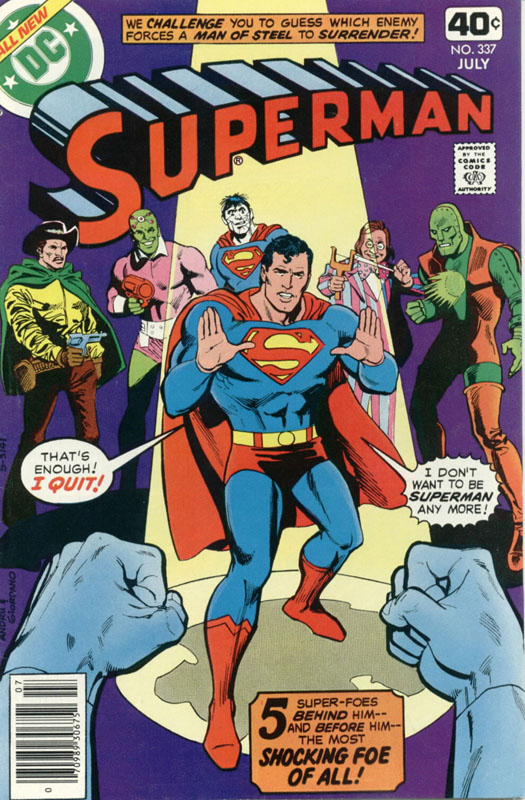


Superman’s villains became far more menacing. Lex Luthor slimmed down, donned a purple battle costume (later green battle armor, taking his fashion tips
from the Joker, no doubt) that allowed him to slug it out with the Caped Kryptonian, and actually murdered people within the pages of comics.
Larger-than-life villains, such as Darkseid (1970), the Galactic Golem (1972), Karb-Brak (1976), and Mongul (1980), proved to be physical matches for
the Last Son of Krypton. Other notable additions to the Action Ace’s Bronze Age supporting cast included Terra-Man (1972), Steve Lombard (1973),
Vartox (1974), Atomic Skull (1976), and Lord Satanis (1982).
Earth-2 Superman
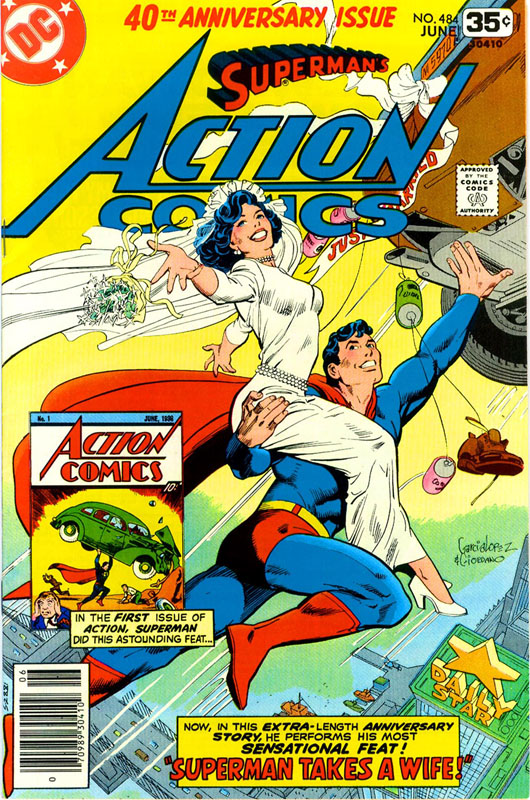
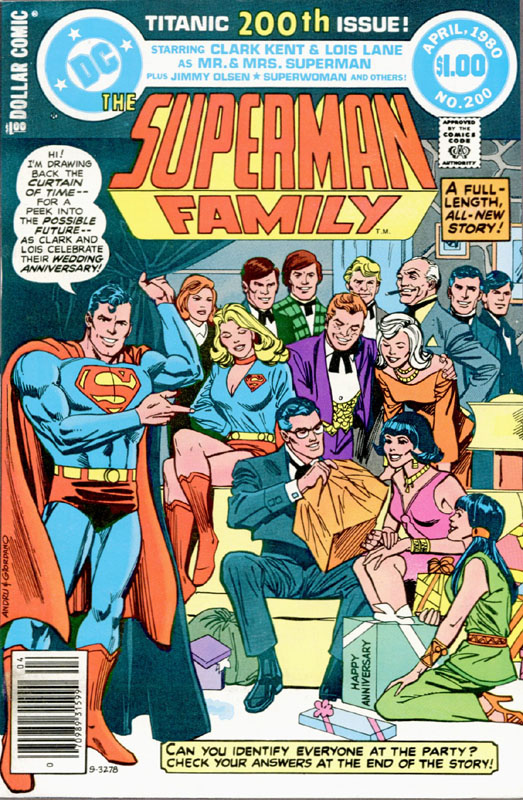
You may ask why the Golden Age Superman is listed again. The answer is that when he began making appearances in the Silver and Bronze Ages (1969), the
original Man of Steel’s character incorporated new elements that made him a different character (in addition to exaggerating minor existing differences).
He was now depicted as graying at the temples to illustrate that he was older than the Earth-1 Superman. He worked at the Daily Star (even though the
Golden Age Superman began working at the Planet in 1939). This Clark Kent was in fact the editor of that newspaper. The “S” emblem on his chest was
drawn differently, in the style exemplified by the early 40s depictions of the Man of Tomorrow. His Kryptonian name was given as “Kal-L” rather than
“Kal-El.” His foster parents were John and Mary Kent. His cousin was Power Girl rather than Supergirl. His arch-enemy Luthor retained the red hair
of his first three appearances in 1940, still customarily wore prison grays, and gained the first name of Alexei. And, in 1978, Clark finally married
his long-time girlfriend Lois Lane, something his Earth-1 counterpart never did except in “imaginary” stories.
Top
Christopher Reeve’s Superman through versions of Brainiac
Lois & Clark: The New Adventures of Superman
Smallville through less direct versions of Superman
Home































































































